Southern Africa September 2018
I have always dreamed of experiencing an African safari. For a biologist and a photographer, an African safari is one of those bucket list life experiences. My wife, Becky, and I had been investigating various options including different African locations, seasons, and tour companies for several years. We decided on the "Ultimate Africa Tour" offered by Overseas Adventure Travel (OAT) which includes camps in Botswana, Zambia, and Zimbabwe. We chose to go in September as it is near the end of the dry season. Benefits of this time period are fewer mosquitos and tsetse flies. Wildlife is more concentrated and dependent on the limited water supply. The deciduous trees and shrubs are leafless which greatly improves the visibility of wildlife. The grasses are grazed or trampled which also makes wildlife more visible to the photographer. This time of year generally has low humidity and few cloudy days, but it can be quite hot. Temperatures above 100 degrees F can, and did, occur. However, these temperatures are comparable to what we experience at home in Northern California during September.
We decided to add on one of the OAT pre-trip extensions to a private "game reserve" in South Africa near Kruger National Park. OAT arranged our air transportation from the U.S. on British Air. We had planned to fly from San Francisco to London (11.5 hour long flight,) have a 4 hour layover, and then catch another 11.5 hour flight to Johannesburg. However, during the course of our London layover we found out that our flight to Johannesburg was delayed about 30 hours. British Air offered us the option to wait for the delayed flight or to fly on South African Air which was scheduled to take off and land about the same time as our original British Air flight. We chose South African Air.
An OAT representative was to meet us at the Johannesburg Airport and arrange transportation to the O.R. Tambo Protea Hotel for an overnight stay. We were not met. Not a good start by OAT. We found transportation and arrived at the hotel early on the morning of September 10. The hotel staff were great and managed to get us in a room by 10AM. We had initially planned to take a bus tour of the city and the the nearby community of Soweto. Soweto is the home of Desmond Tutu and Nelson Mandela. Having little or no sleep on the planes we instead opted for a nap.
After breakfast the next morning, we met our seven fellow OAT travelers and were transported to the airport where we boarded a smallish turboprop plane for a short hop to Hoedspruit, South Africa. Hoedspruit was easily the smallest airport I have ever been in. The parking lot was full of safari trucks and numerous vervet monkey.
Our driver met us and loaded the bags into a large van. OAT provides travel duffle bags and insists that you use them. Each traveler is limited to a total of 44 pounds. Almost half my weight was camera equipment and supplies. We were hardly out of the parking lot and saw the first of many impala and several giraffe grazing along the road. We were transported over good blacktop roads for about two hours to Karongwe River Lodge, close to the Drakesbad Escarpment. In route we passed numerous "game reserves" cattle ranches and citrus farms.
I was a little unclear on the whole premise of a game reserve, but Karongwe was a 20,000 acre former cattle ranch surrounded by 10 foot high electrified fence to keep wildlife in and poachers out. I had been advised that the game reserves almost guaranteed sightings of the Big Five (lion, leopard, buffalo, elephant and rhino) and that the remainder of our camps were unlikely to have rhino. I believe that the reserve may have been initially stocked with some wildlife species and that they actively trade animals with other reserves.
We were met by the staff and manager with cool towels and drinks and ushered to our rooms after a lodge safety briefing. We were also requested to sign a liability waiver. Our room was huge. High ceilings, four beds and air conditioning.
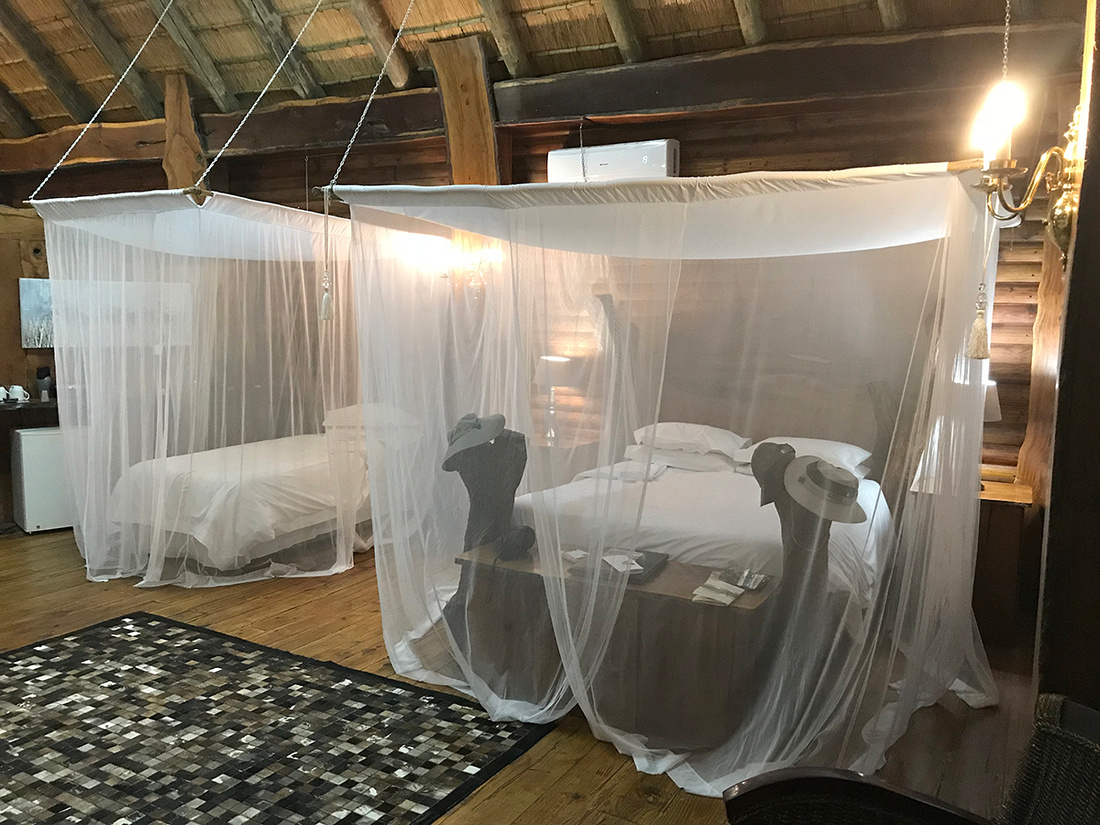

The bathroom was also spacious and contained a large shower and a claw foot tub. We unpacked and got ready for high tea (a British tradition that always included tea and dessert). We met our guide (Mathew) and our tracker (David). The reserve was the only camp where we had both a guide and a tracker on each vehicle. The tracker rode on a special seat attached to the left front fender. After high tea we loaded all nine of us into safari vehicles. The safari vehicles were a little different in each camp. At Karongwe, they were new Toyota 4W drive trucks with an aftermarket set of three tiered bench seats bolted to the bed. Getting into the seats required some agility.
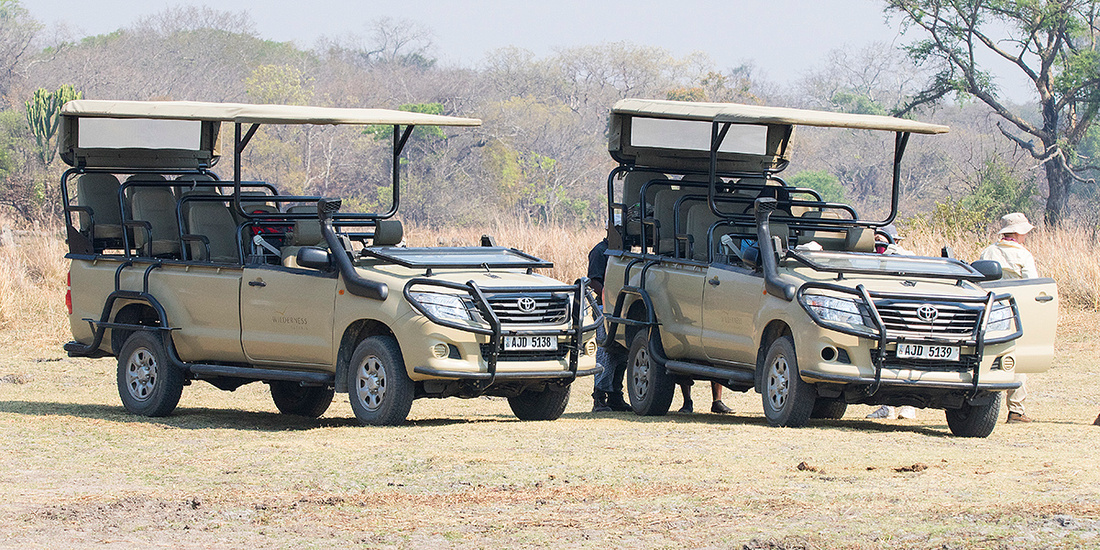

We loaded up and departed on our first game drive. I am not sure what I expected, but I did not expect two mature leopards on a fresh nyala kill within 1/4 mile of camp. A very good start. We soon discovered one of the advantages of a private reserve over the National Parks is the ability to go off-road. We murdered many trees tracking the leopards to a brushy gully where they were enjoying dinner. I was very excited to see my first leopards, but they were in a very difficult location for photography. Over the next four hours or so we saw waterbuck, kudu, impala, white rhino, cheetah, crocodile, nyala, wildebeest, giraffe, dukier, warthog, baboon, vervet monkey, bushbuck and the same two leopards again. The cheetahs were just finishing up an impala kill they had made. The kill was out in the open, but the light was fading. I got a few keeper images of the cheetahs, but many were blurry.
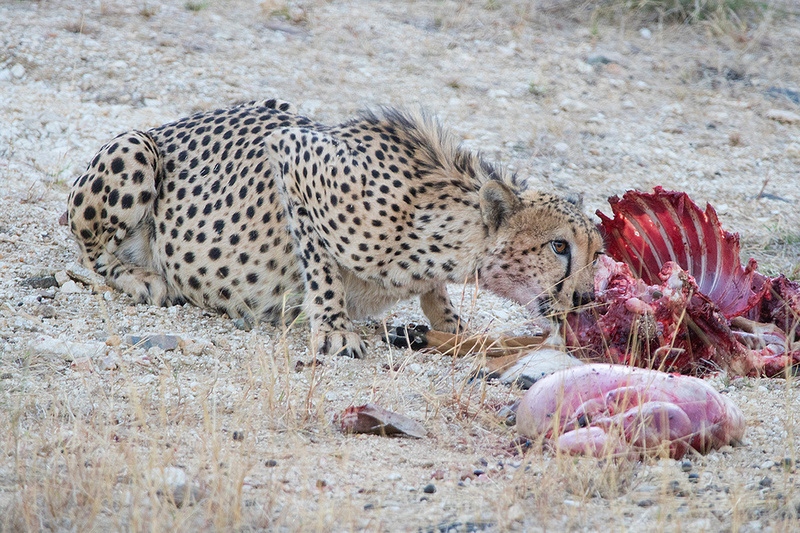
 Cheetah on kill
Cheetah on kill
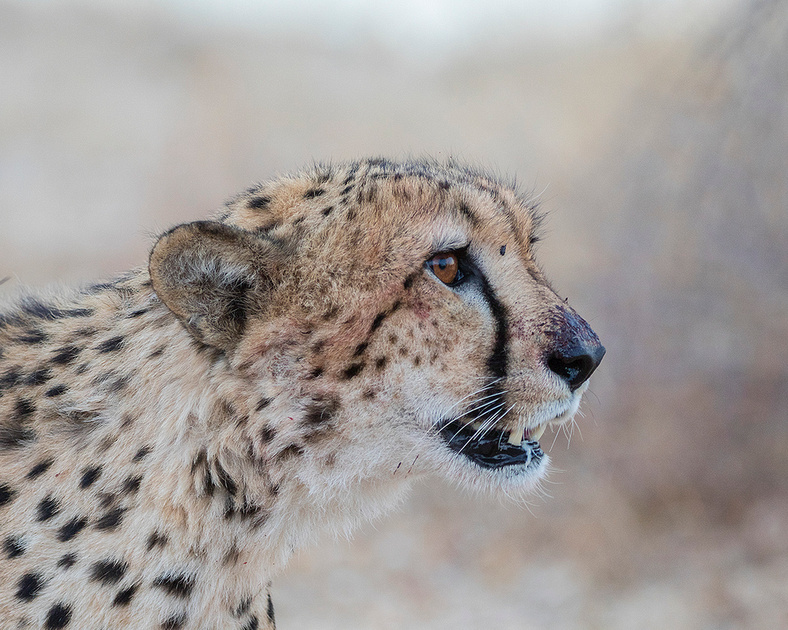
 Cheetah
Cheetah
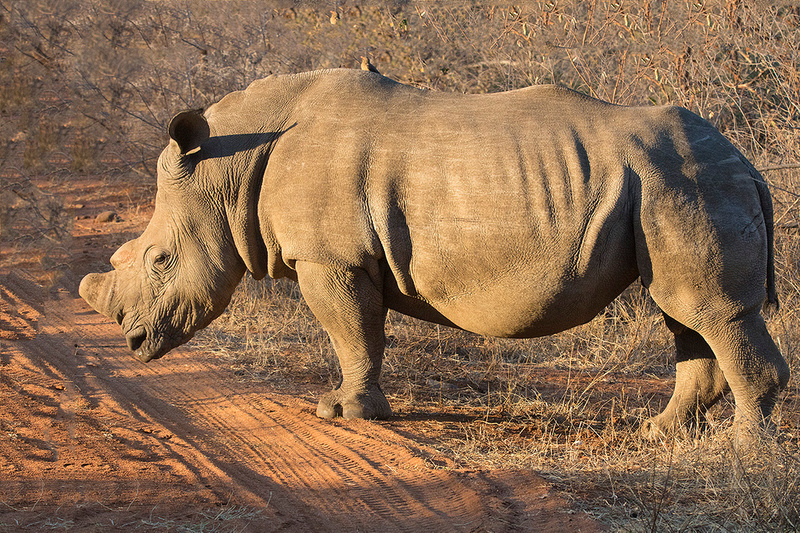

White Rhino (Note the Red-Billed Oxpecker on the Shoulder)
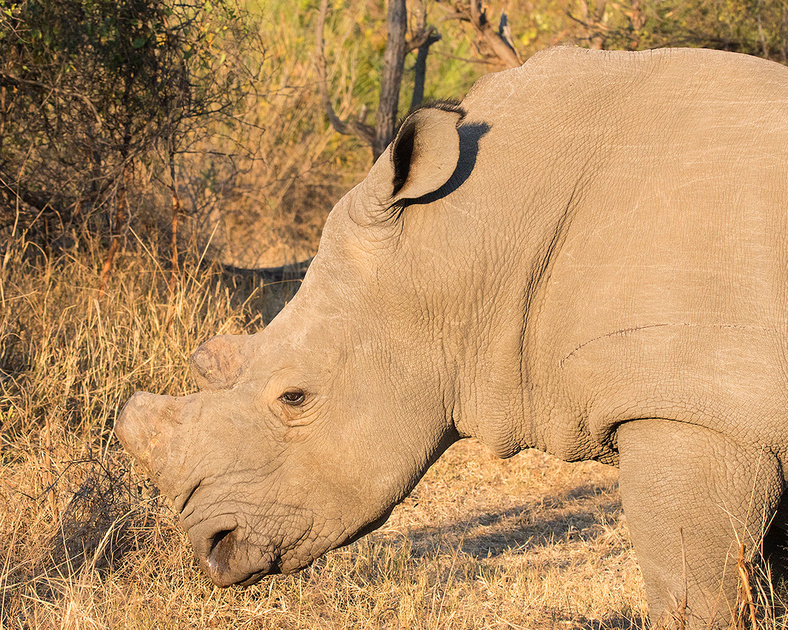
 White Rhino (Note the horn has been removed to deter poaching)
White Rhino (Note the horn has been removed to deter poaching)
We stopped just before sunset and experienced another African tradition, the sundowner. The guide parked and set up the bar on the hood. Everyone had a drink as the sun set. A very nice tradition. On the drive back to the lodge the tracker used a spotlight to locate nocturnal wildlife. We did see a civit cat briefly using the light.
We had time for a short happy hour before dinner. The local lagers were Castle and Carlton Black Label. Dinner was quite good and included ostrich kabobs. In fact all the food at the lodge was quite good. At this location we ordered off the menu as opposed to the buffets which were the norm on the remainder of the trip. Dinner was served outside on the patio overlooking the Makutsi River bed. We were escorted to our room after dinner by the guides. We were not allowed to walk at night in any of the camps unescorted.
We were up before daylight for coffee and pastries before heading out on our morning game drive and continuing quest for the Big Five. Temperatures were in the high 40s and low 50s each morning. It was prudent to dress in layers as it was pretty cool traveling in an open vehicle.
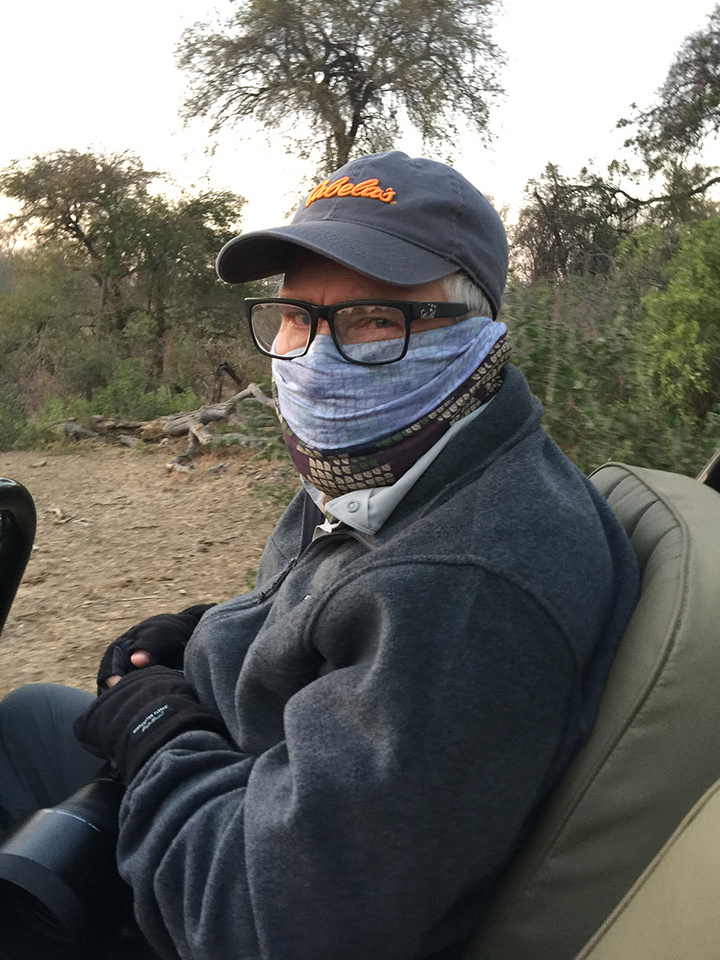

The Author Bundled up for the Arctic
It warmed up most days to the high 70s. I was the only birder in the group. The guide was good about pointing out each new bird species. In addition to the wildlife species we had seen the previous evening we also observed elephants, zebras, jackals, hippo, steinbuck, and dwarf mongoose.
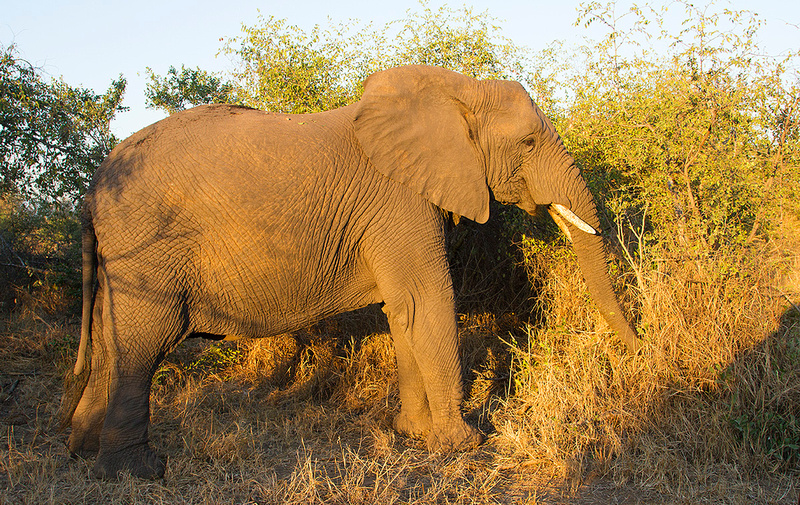
 Elephant in Warm Morning Light
Elephant in Warm Morning Light
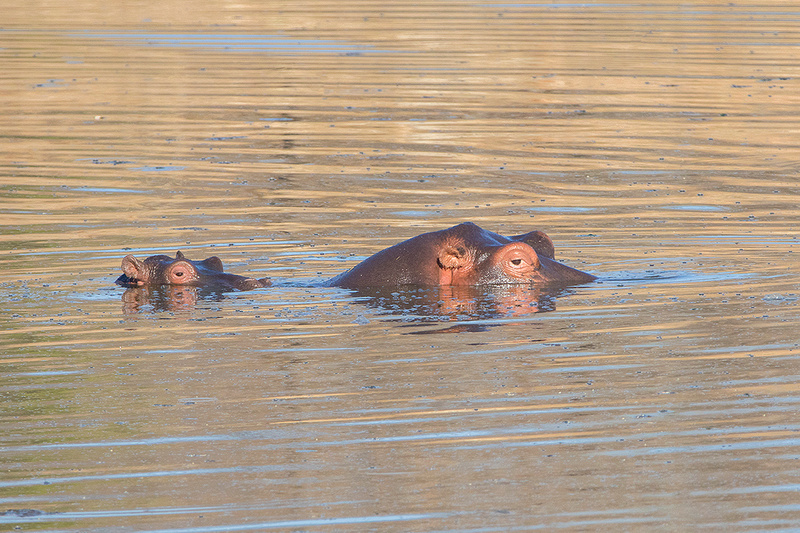
 Back Riding Baby Hippo
Back Riding Baby Hippo
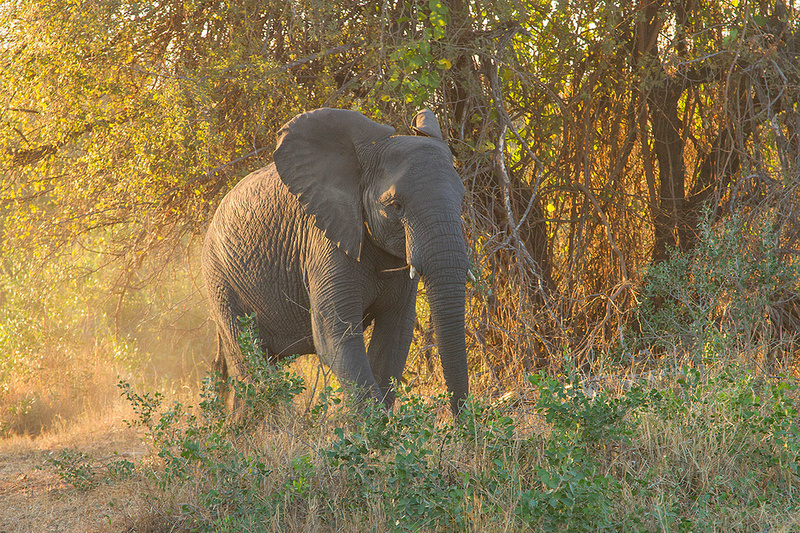
 Elephant on the Move
Elephant on the Move
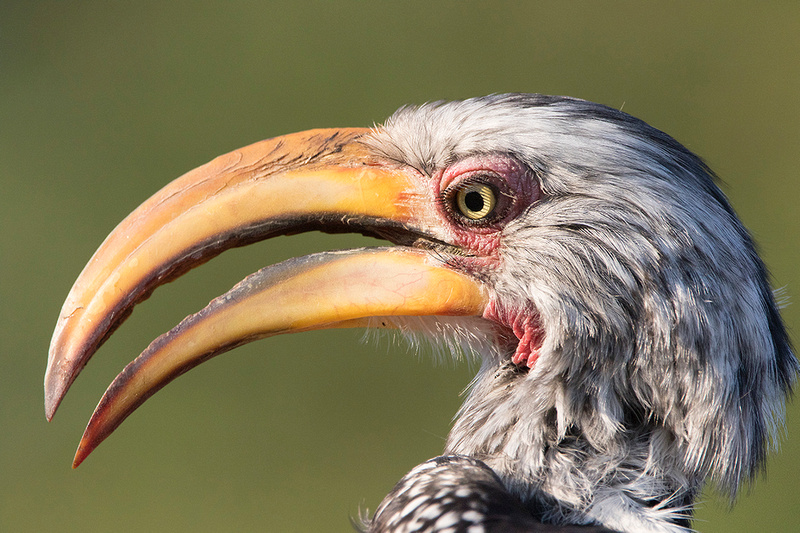
 Southern Yellow-Billed Hornbill
Southern Yellow-Billed Hornbill
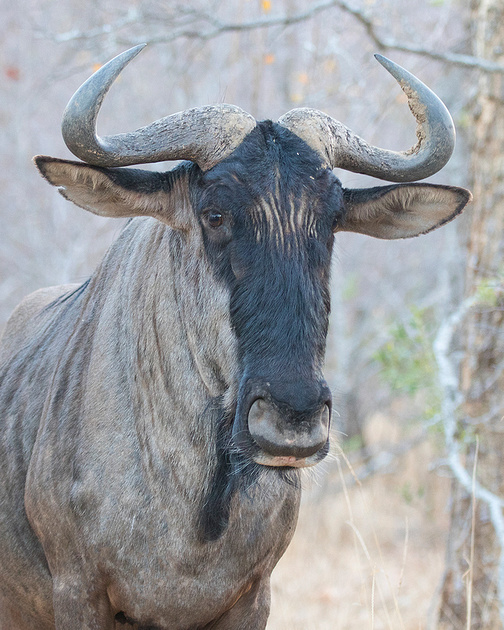

Wildebeest
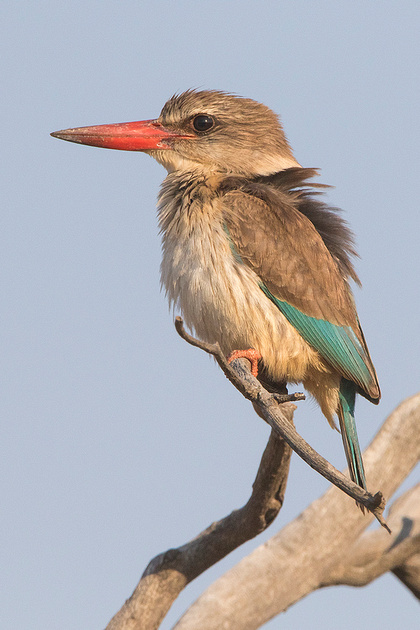

Brown Hooded Kingfisher
We saw two additional white rhino. They have over thirty rhinos on the reserve. Each has a unique ear notch pattern to allow the guides to identify individual animals. The horns on all the rhinos had been removed to prevent poaching. On our evening game drive we found six lions sleeping in some dense brush. We parked within eight feet a of a large sleeping male. Too close! Great mane, but again brush and grass were difficult to shoot through and my first lion images were less than perfect. Unfortunately, these were almost our only lion sightings at the reserve.

 Young Male Lion
Young Male Lion
We had another day of morning and evening game drives on September 13. We found a herd of buffalo to complete our Big Five.
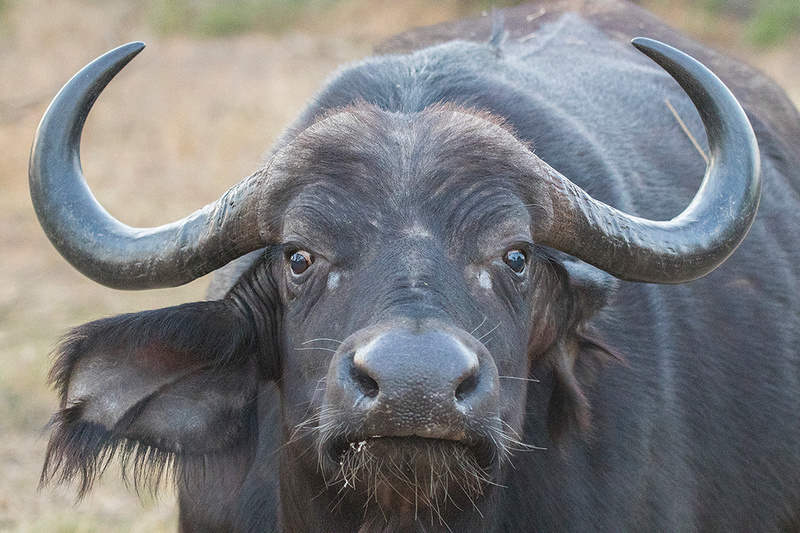
 Adult Cow Buffalo
Adult Cow Buffalo
We also observed elephant and several rhinos. The buffalo were mostly cows and calves. We parked the truck and they feed all around us within twenty feet or so, at first light. I discovered that the lodge had a wildlife viewing blind at the waterhole (large shallow pond) adjacent to camp. I spent most of the time in camp working on my bird life list at the waterhole and attempting photography in the harsh mid-day light.
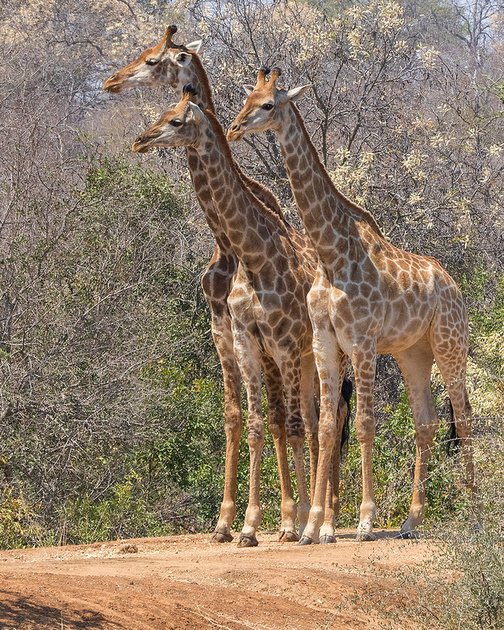

A Tower of Giraffes
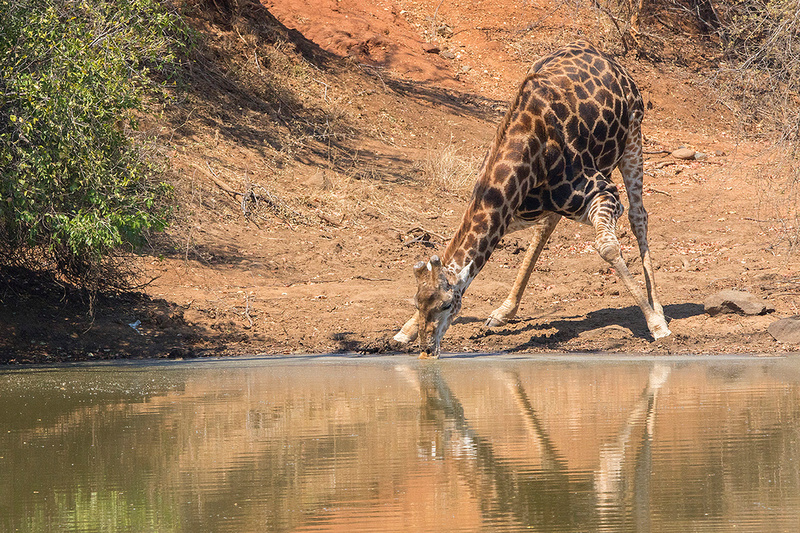

I was able to photograph a pair of amorous crocodiles at the waterhole.
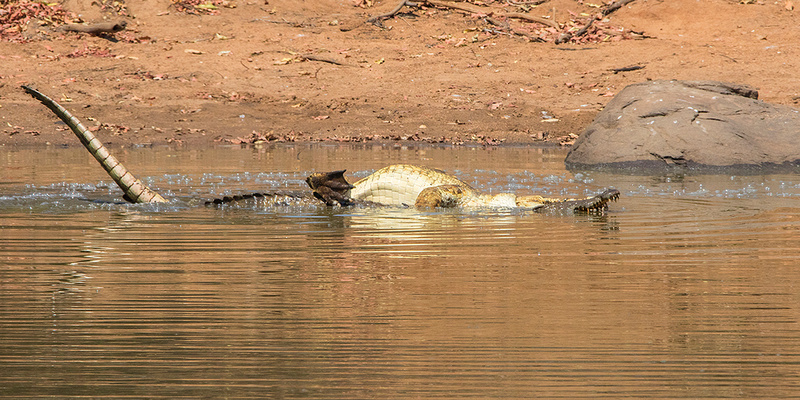
 Mating Crocodiles
Mating Crocodiles

 African Fish Eagle Territorial Dispute
African Fish Eagle Territorial Dispute
On our evening game drive the tracker observed two distant giraffe acting oddly. We drove closer and found the source of their behavior; a mature leopard was streched out in the open on the ground in front of an abandoned lodge. I took hundreds of photos at fifty feet. Such a beautiful animal. We discovered that he had made a recent kill and had hid it (impala) under the lodge building. He eventually strolled around under the building and began to feed.

 Adult Leopard
Adult Leopard

 Adult Leopard
Adult Leopard
Another morning and evening game drive on September 14. We saw a black-backed jackal. We had previously seen only the side-striped jackal species. We had a brief sighting of a lioness. We saw the three cheetahs (brothers) asleep in the morning sun. They pretty much ignored us and offered few photo opportunities.
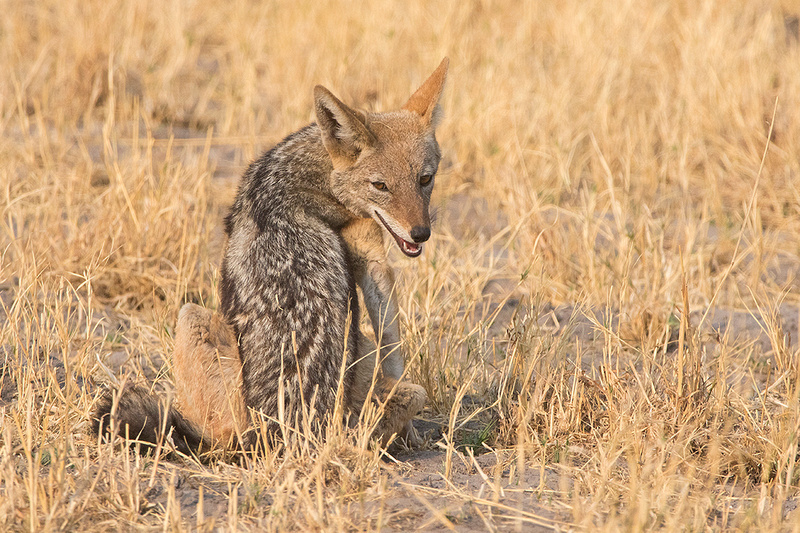
 Black-Backed Jackal
Black-Backed Jackal
September 15th was our last morning at the reserve. We spent most of the morning searching for lions, but came up empty. This game drive was the only time we saw one of the perimeter fences. We followed the fence line and parked the truck. The guide unloaded all of us and walked us to within twenty-five feet (yes feet) of three cheetahs on a fresh kill. I got a number of decent images of the brothers grooming each other.
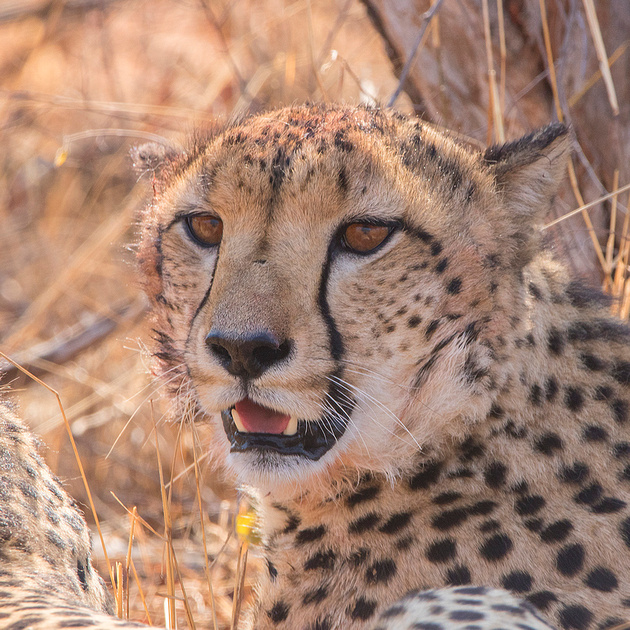
 Cheetah
Cheetah

 Cheetahs Grooming
Cheetahs Grooming
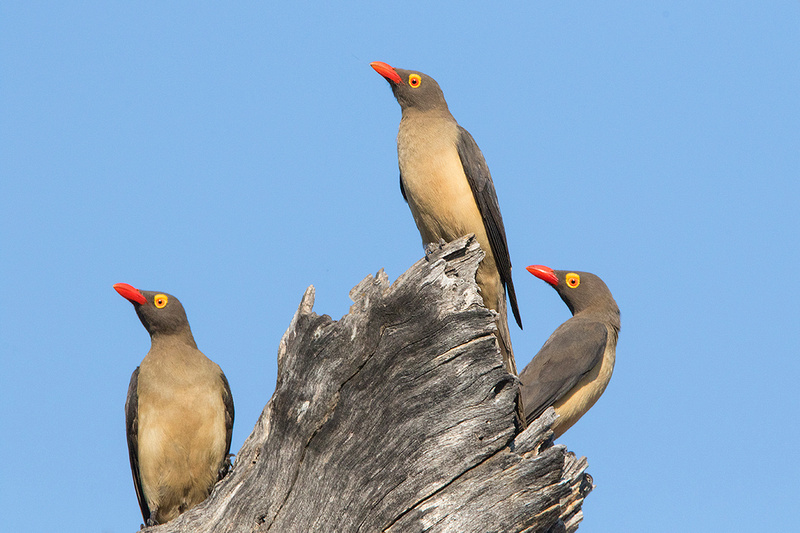
 Red-Billed Oxpecker
Red-Billed Oxpecker
After the morning game drive, we retraced our steps back to the Hoedspruit Airport, flight back to Johannesburg and then to the O.R. Tambo Protea Hotel for another overnight stay. The next morning we met the remainder of our tour, which consisted of five additional travelers.
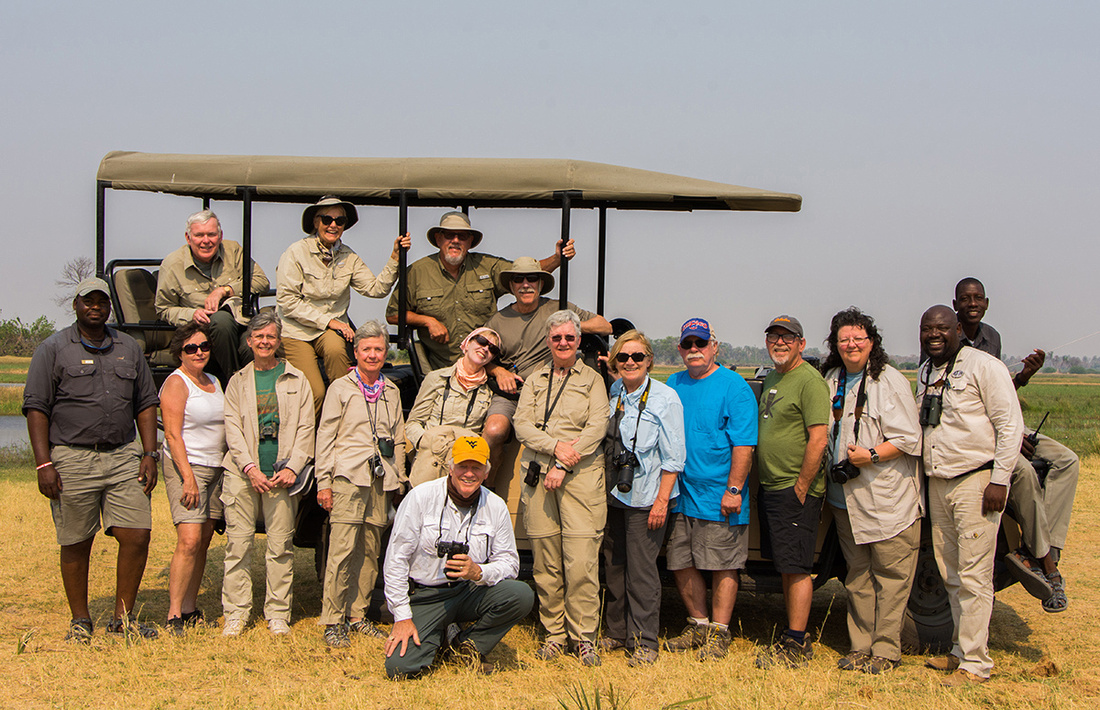

Photo Credit: Stephen Cochran
We caught a commercial British Airways jet for transport to Victoria Falls, Zimbabwe where we were met by our OAT Trip Leader. It took over an hour to get all of us through immigration and to pay our visa fees.
I should mention a few things about OAT. They specialize in small group travel, advertising never more than 16 travelers on a tour. All of the participants on our tour were Americans. Most of the people on our tour were repeat OAT customers. This was the 19th OAT trip for one of our tour members. Most of the group had traveled with OAT several times and one member had previously done this same tour about fifteen years ago. The pre trip extension was all about the game drives. The main tour included lots of game drives, but also several cultural experiences. We visited a school and a homestead within a village while in Zimbabwe. During high tea, staff at each of the camps made presentations each afternoon on subjects varying from making peanut butter to the HIV epidemic.
After clearing immigration we took a bus to the entrance of Hwange National Park (Zimbabwe's largest park). We were met at the park entrance by our safari guides Victor and Abut who transported us through the park to Kashwe Camp, our home for the next several days. This camp and all the others on the tour was operated by Wilderness Unlimited and provided tents of some form for lodging. The tent was roomy, clean, and comfortable with solar water heating and electricity. Each room had a large stand fan for cooling. It was significantly warmer here than in South Africa. This was the only camp where we were escorted to our tents each evening by an armed guard.


Becky on the Veranda of our Kashawe Camp Tent
All meals were served buffet style and we sampled some local sorghum beer. Definitely an acquired taste.
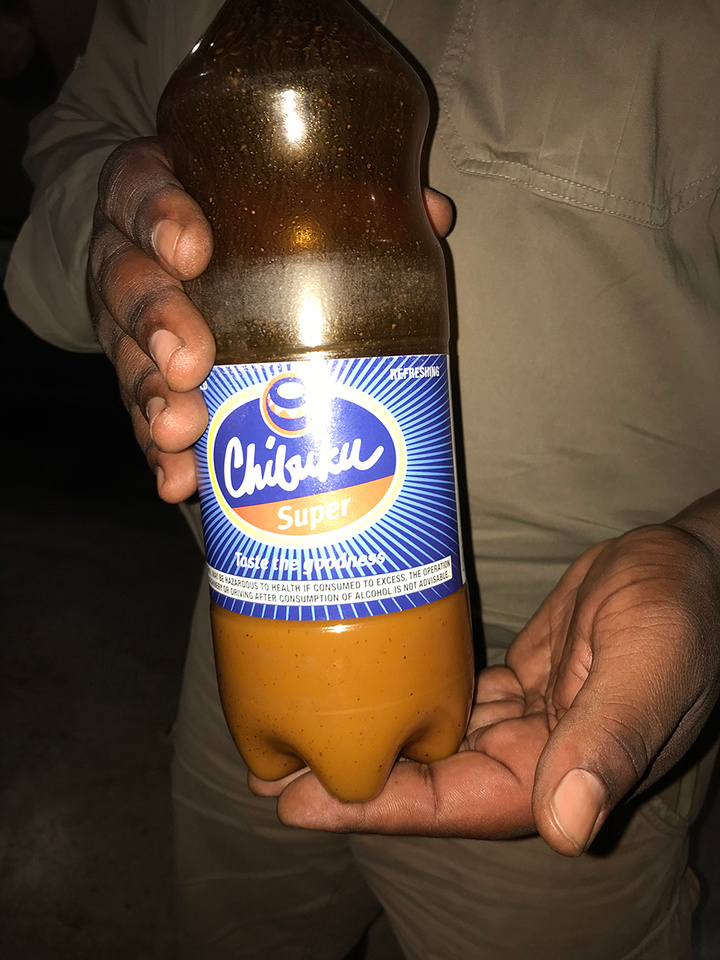

Sorghum Beer
The camps all provided complimentary laundry service which allowed us to pack light on clothes. The park was quite dry with only isolated surface water. The entire park appeared heavily over grazed by elephants Damaged and downed trees were common.


Elephant Damaged Baobob Tree
Wildlife was not as abundant or as diverse as at the game reserve and was difficult to locate away from water. We did observe a very large herd of buffalo at a great distance and many elephants. No cats or rhinos. We also had opportunities to photograph a number of avian species including the stunning lilac-breasted roller.
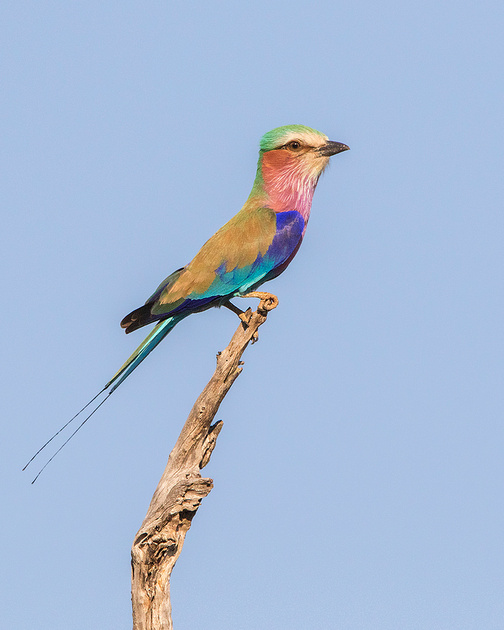

Lilac-Breasted Roller
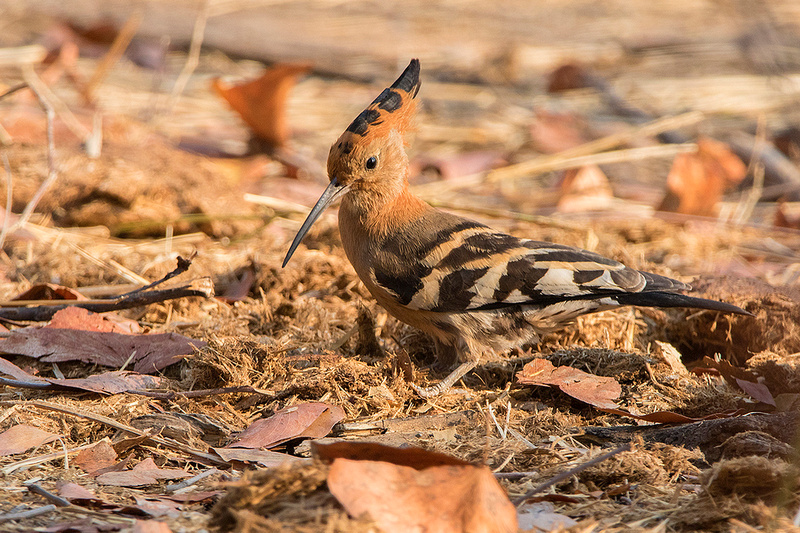
 African Hoope
African Hoope
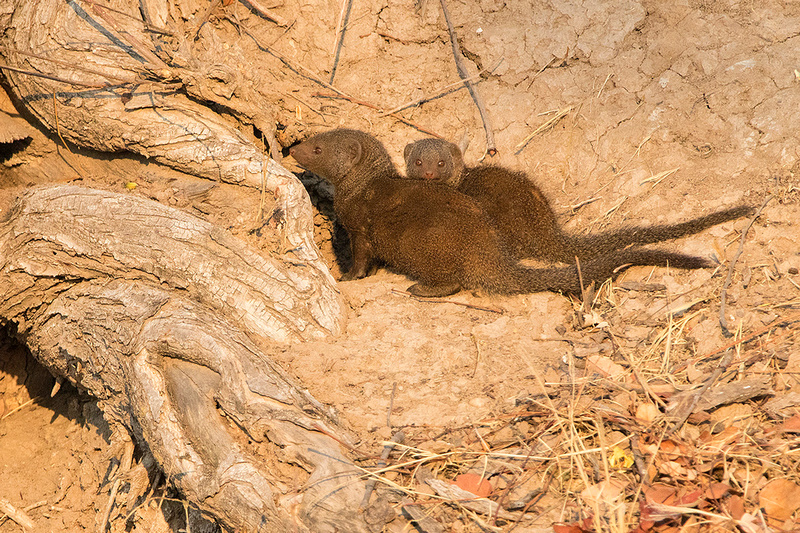
 Dwarf Mongoose
Dwarf Mongoose
On our last full day in camp we enjoyed an "all day game viewing drive". Highlights of the drive were a visit to an isolated waterhole with an excellent elevated viewing blind. We spent several hours at the blind and enjoyed the antics of an elephant drinking and cooling off, a hippo territorial dispute, several crocodiles with a recent impala kill, and a large troop of baboons.
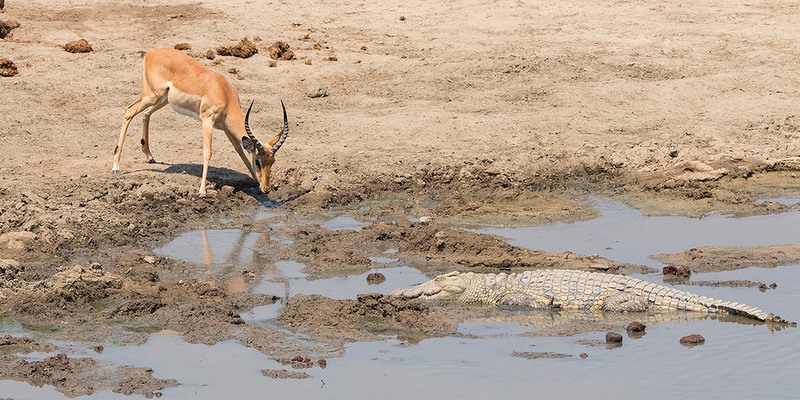
 Impala and Crocodile
Impala and Crocodile

 Crocodile and Impala
Crocodile and Impala

 Baboon Female and Young
Baboon Female and Young
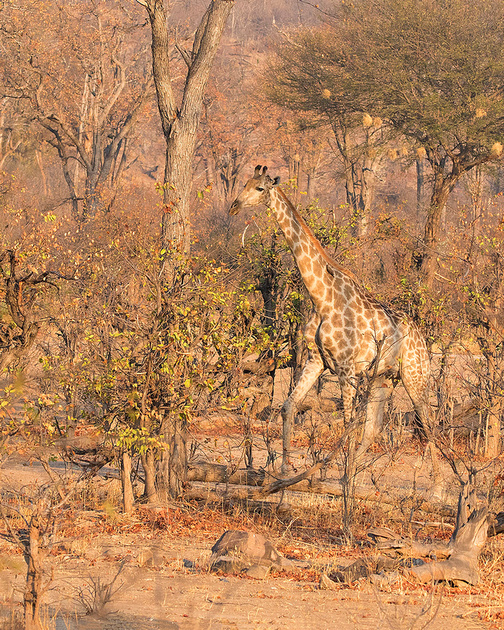

Sunset Giraffe
The next morning we departed Hwange National Park and crossed the border between Zimbabwe and Zambia. The border crossing was quick and smooth. We briefly toured a open air market in Livingstone, Zambia where our trip leader purchased mopane worms, a local delicacy.
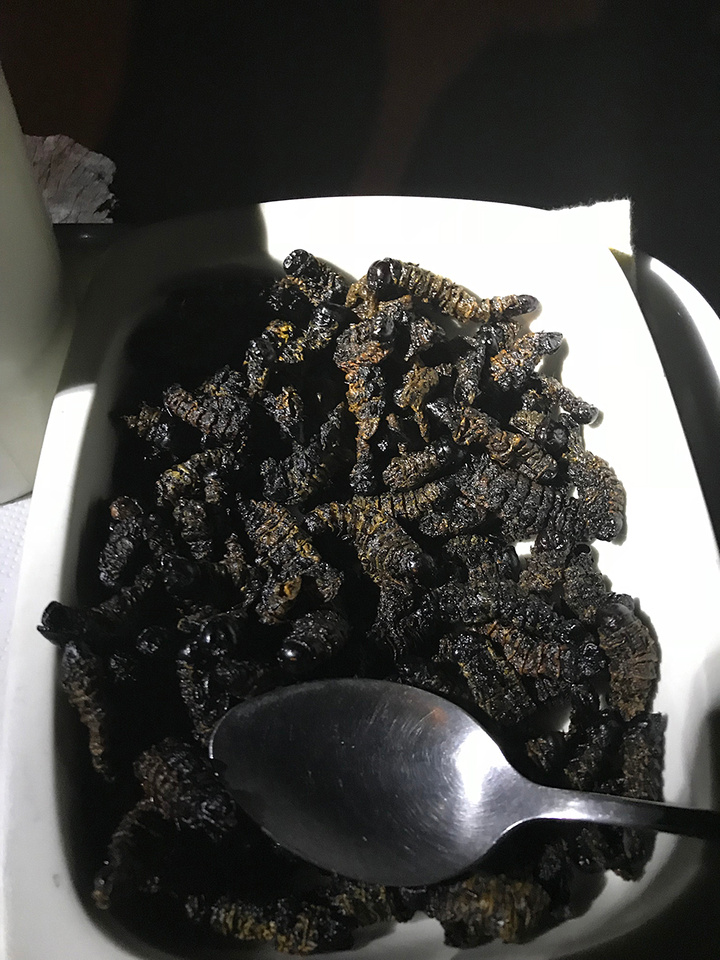

Mopane Worm- A Chewy and Crunchy Local Delicacy
We utilized the Livingstone Airport to catch our next flight to Lufupa River Camp in Kafue National Park in Zambia. This park is about 8,600 square miles in size. We divided up the group and flew in two small planes. Smooth flights and landings.
Lufupa River Lodge is located at the intersection of two large rivers (Kafue and Lufupa). Game drives at this location included both safari trucks and boats. Our tent was clean and comfortable, although afternoon temperatures were getting into the mid 90s. Zambia is the only country we visited where the tetse fly is present. Each vehicle had a large can of dried elephant dung attached to the back bumper. This dung was lit on fire and was reputed to be an effective tetse fly deterrent. We saw few flies, so perhaps it worked. I do know that when ever the vehicle stopped we were engulfed in choking clouds of elephant dung smoke.
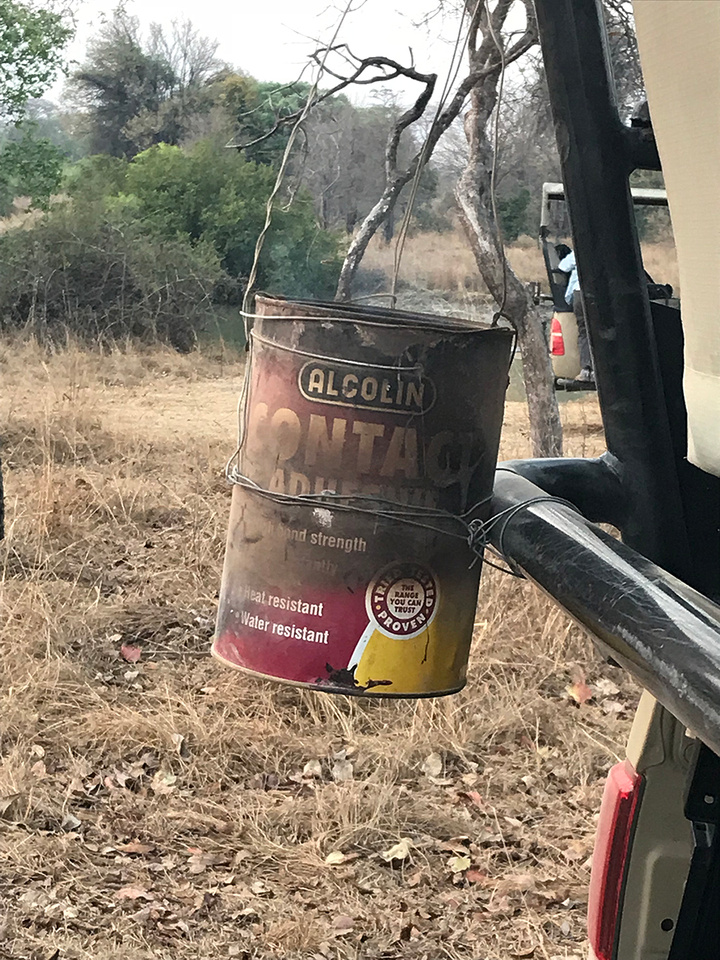

Burning Elephant Dung as a Tetse Fly Repellent
After a quick transfer from the landing strip to the lodge we set out on an evening game drive where we observed puku, an stocky antelope found only in Zambia and the Congo. We also observed a small herd of Lichenstein's hartebeest and a white-tailed mongoose while spotlighting on our way back to camp.
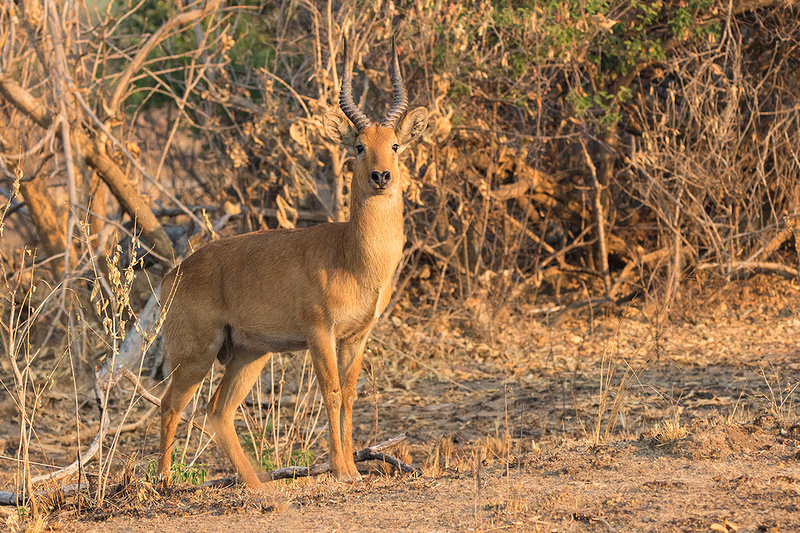
 Puku
Puku
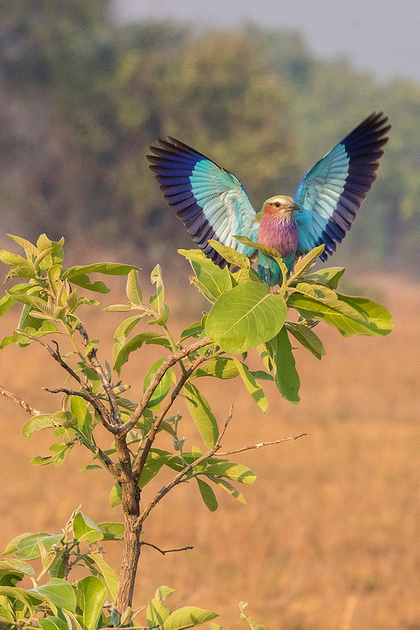

Lilac-Breasted Roller
On September 19th we enjoyed morning and evening game drives in the safari trucks. We saw a number of new bird species including the African finfoot, but otherwise the game drives were relatively unproductive with no sightings of the Big Five. On September 20th we explored the Lufupa River via a patio boat. Lots of hippos and crocodiles. We saw our first monitor lizard and several species of kingfisher.
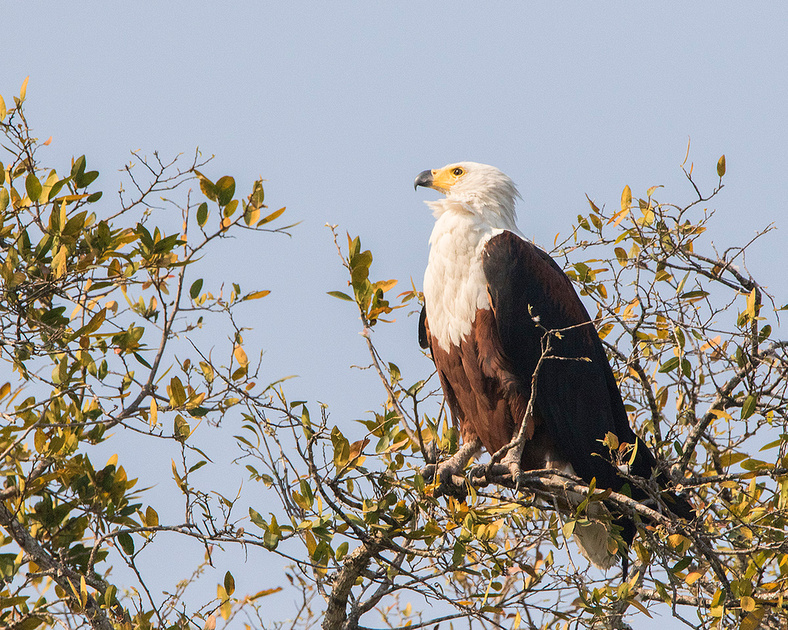
 African Fish Eagle
African Fish Eagle
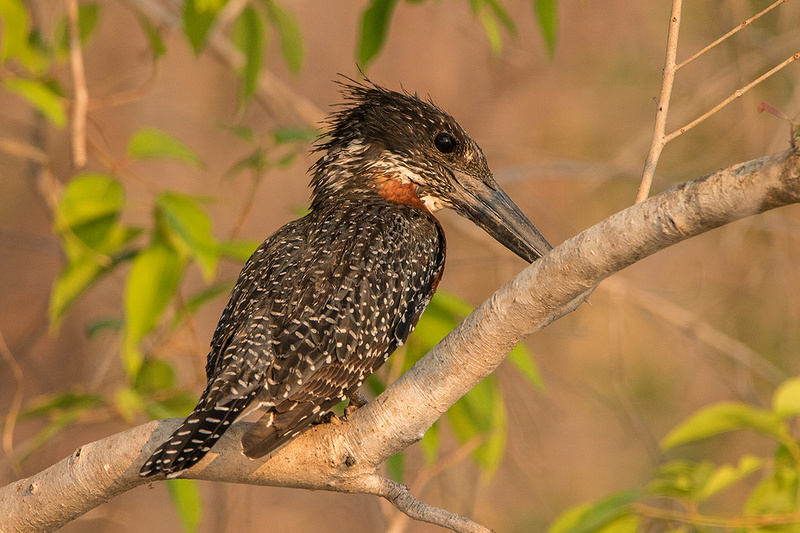
 Giant Kingfisher
Giant Kingfisher
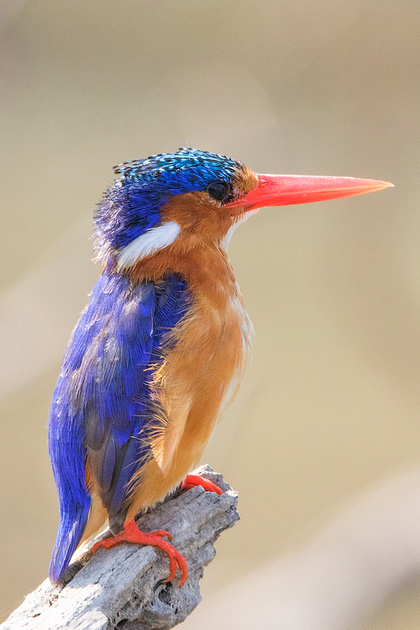

Malachite Kingfisher


Pied Kingfisher
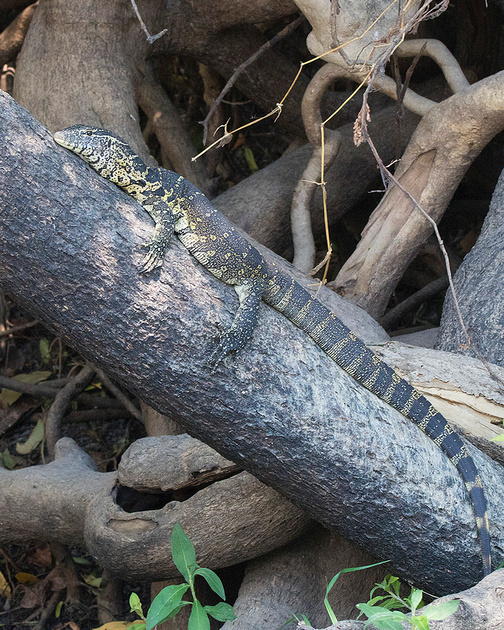

Water Monitor
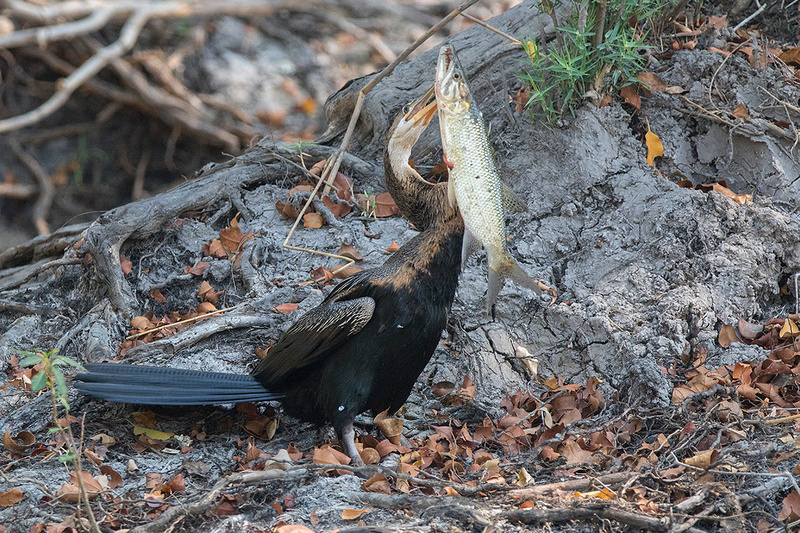
 African Darter with Pike
African Darter with Pike
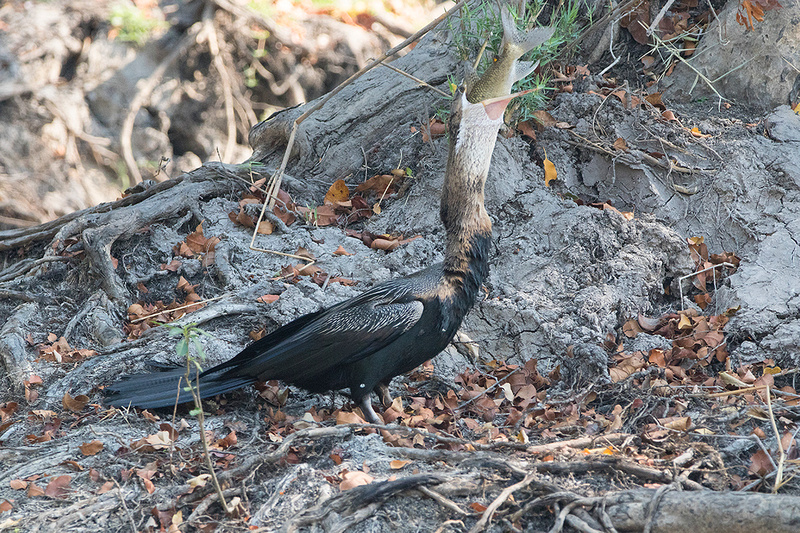
 African Darter Swallowing Pike
African Darter Swallowing Pike
Our tents were installed on the banks of the Kafue River and each had excellent views of the river.
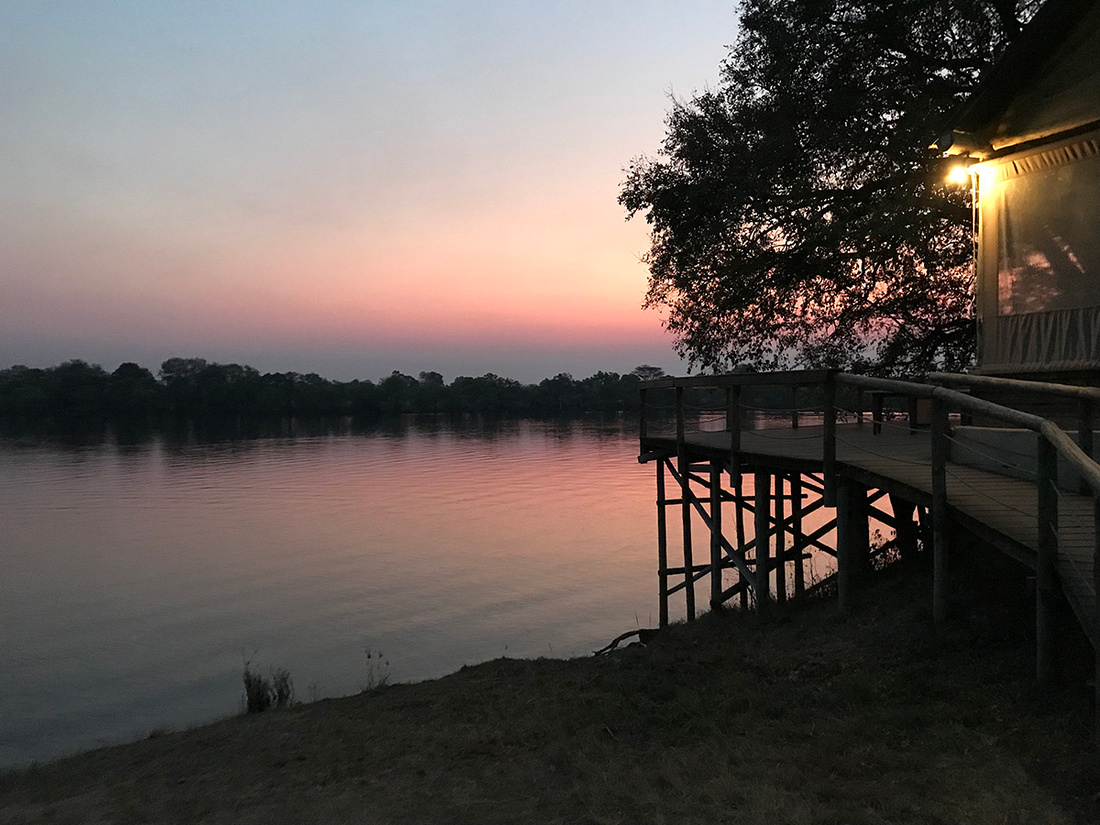

Lufupa River Camp

 Grey Crowned Crane
Grey Crowned Crane
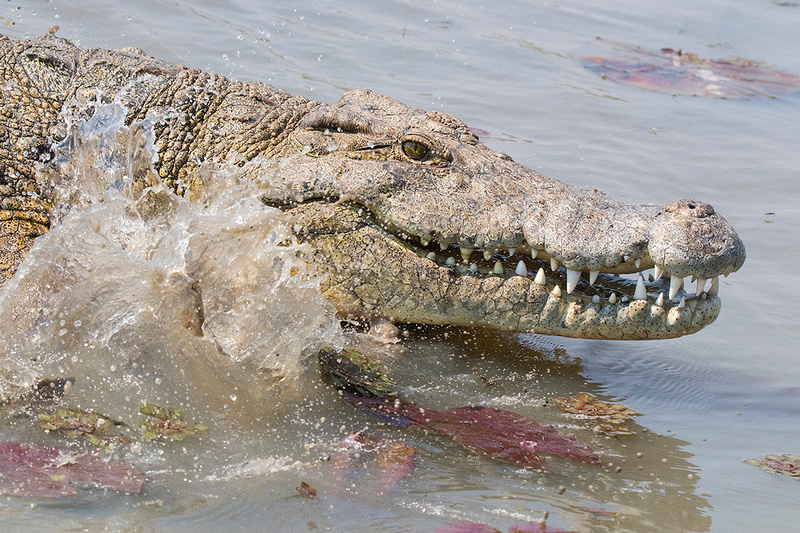
 Kafue River Crocodile
Kafue River Crocodile
We were visited by a large troop of vervet monkeys each day. They spent a good deal of time using out tent as a trampoline and peering through the screen at us while we showered. The females all seemed to have very young and dependent babies. All the babies appeared to be about the same age.
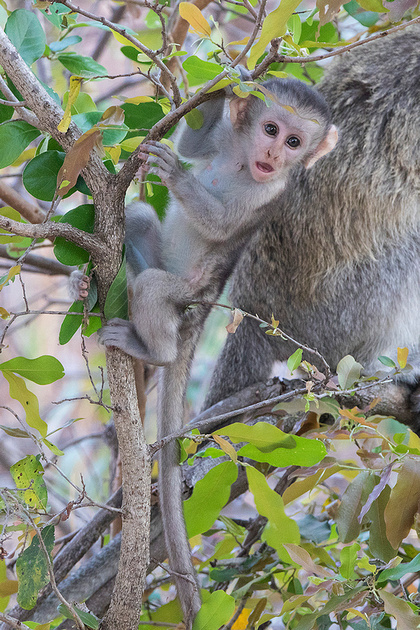

Young Vervet Monkey


Adult Vervet Monkey
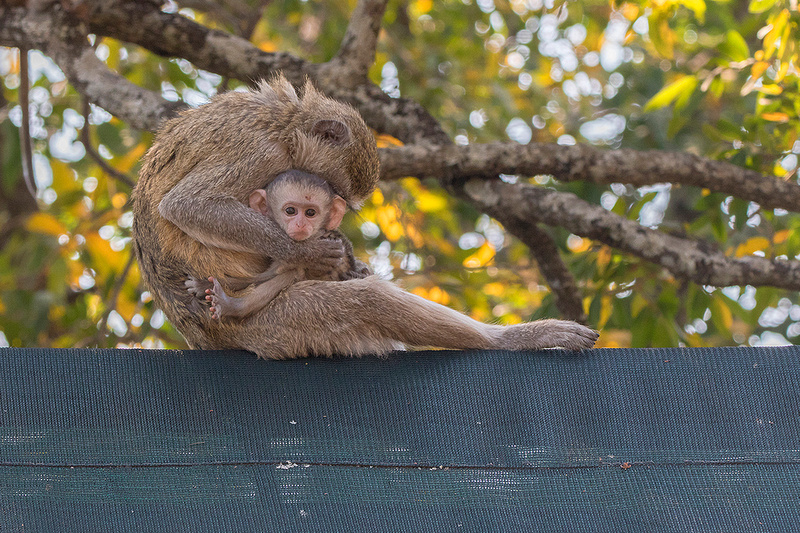
 Vervet Monkeys on our Tent
Vervet Monkeys on our Tent
We also had our first elephant in camp experience as two adult bulls visited almost daily. Brian, one of our guides, called them naughty elephants as they have a history of charging slower tourists. We were treated to a picnic lunch on the river several miles from camp. A nice surprise. On September 21st we had another unproductive game drive followed by a very smooth flight back to the Livingstone Airport.
We headed south out of Livingstone towards Botswana with a brief stop to view a small herd of white rhinos. Each rhino had an assigned ranger that guards him or her 24 hours a day and 7 days a week. I am glad we made this stop as it was the only opportunity to view rhino for those travelers who had not been on the South African pretrip and the only opportunity to photograph rhino with intact horns.
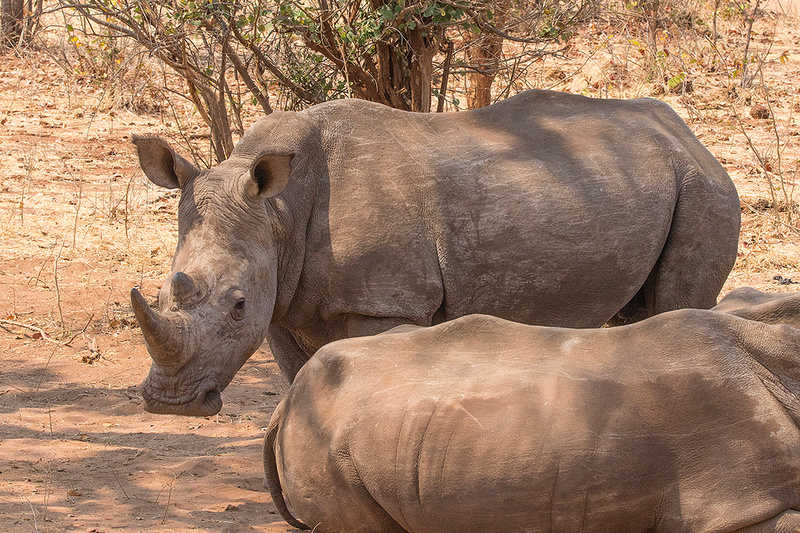
 White Rhino Bull
White Rhino Bull
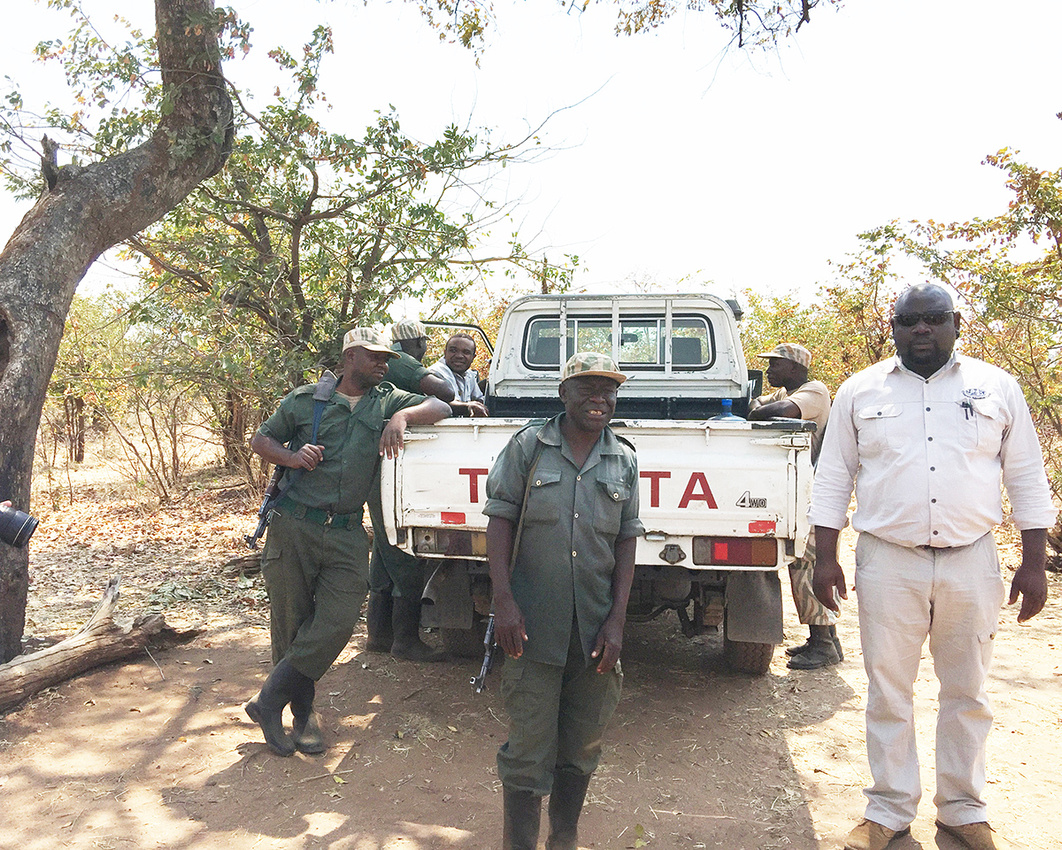
 White Rhino Wardens: Note the Automatic Weapons
White Rhino Wardens: Note the Automatic Weapons
We proceeded south and crossed the Chobe River via a large boat into Botswana. We drove through Chobe National Park on the way to Baobob Camp. Chobe National Park contains an estimated elephant population of over 50,000. This camp was situated on a steep hillside overlooking the broad Chobe River floodplain. Excellent views from the elevated dining area with thousands of animals visible across the floodplain.

 Chobe River Floodplain
Chobe River Floodplain
We checked into our tents. These had stone walls with a tent roof. After high tea, we set out on our first game drive onto the floodplain outside of the park. I was able to photograph a small herd of old male buffalo. The guide indicated that they could no longer keep up with the herd and banded together as protection from predators. Some very impressive heads in the herd. I was surprised to learn that big game hunting is no longer legal in Botswana. Lots of baboon, zebra, waterbuck, and bird life were present. The post game drive welcoming dinner prepared by Chef Oly was quite good as were his magic tricks.

 Bull Buffalo
Bull Buffalo
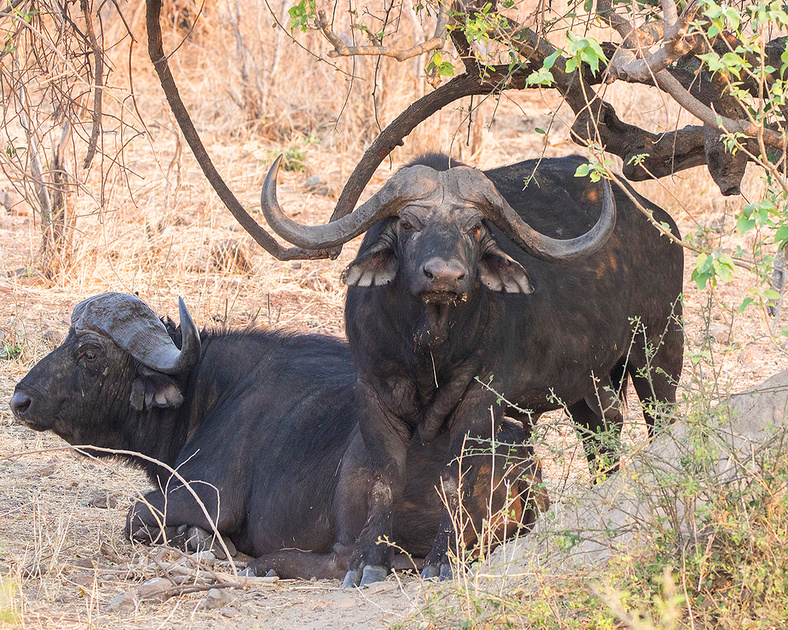
 Bull Buffalo
Bull Buffalo
Our morning game drive on September 22 along the floodplain in Chobe National Park encountered thousands of impala and zebra. We saw a large male sable antelope, a first for the trip. Our lodge was about a ten minute drive from the park entrance. We saw a lone spotted hyena crossing the road before sunrise. Difficult light for photography. We also saw an enormous crocodile sunning on the river bank. He was quite wary and slipped into the river while we were still hundreds of yards away. On our afternoon game drive we came across a small herd of elephant and lesser numbers of zebra, impala, baboon, and kudu than we observed on the morning game drive.

 Impala Rams Sparing
Impala Rams Sparing
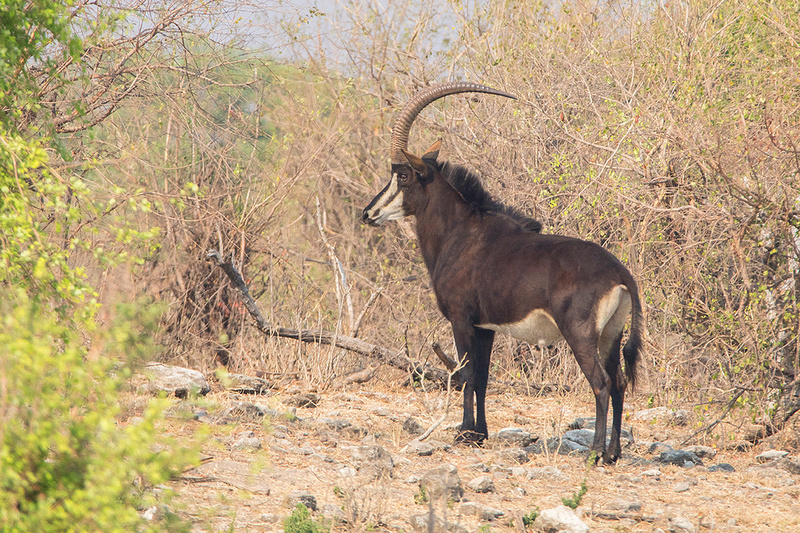
 Sable Antelope
Sable Antelope
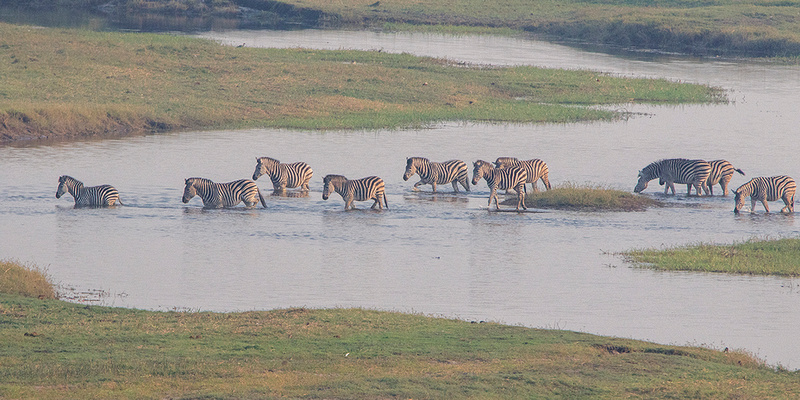
 Zebra Herd Crossing the Chobe River
Zebra Herd Crossing the Chobe River
The morning and evening game drives on September 23 did not yield any new mammal species. Towards sundown we photographed a giraffe as he worked his way through the brush and emerged onto the open floodplain to drink in nice warm evening light. We also saw our first southern carmine bee eaters. A beautiful migratory species that has just arrived back in Botswana.
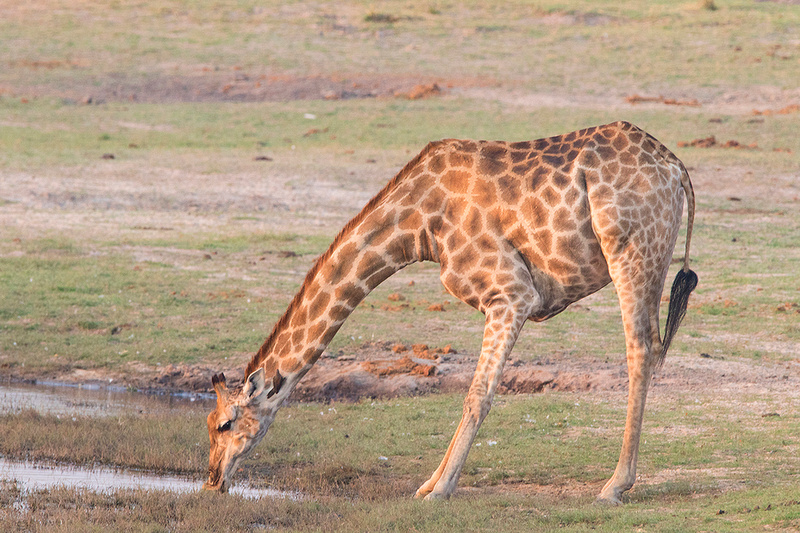
 Adult Giraffe
Adult Giraffe


Giraffe (Note the Piles of Elephant Dung)
We further explored the park on an all day game drive on September 24. We had great looks at two adult male lions and then raced to a reported leopard sighting.
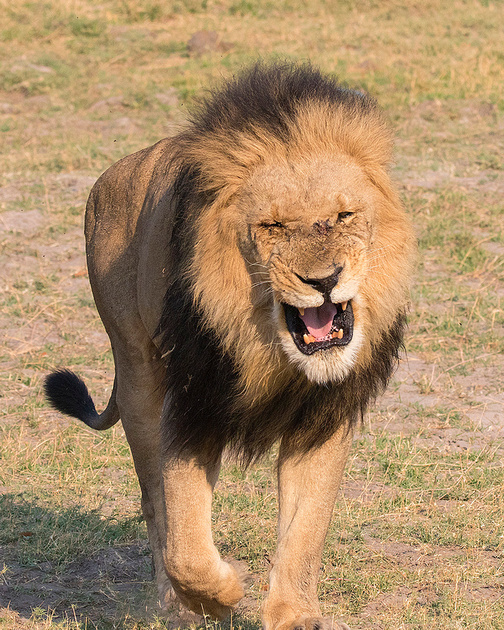

Male Lion


Male Lion
Both sightings were excellent for photography. It turned out that there were three leopards, possibly an adult female and two mostly grown young. They had stashed an impala in a tree next to the road and we were able to observe and view them at extremely close range. This was the only time on the trip where there was a bit of a traffic issue as over a dozen vehicles were crowded together hoping for a clear view.
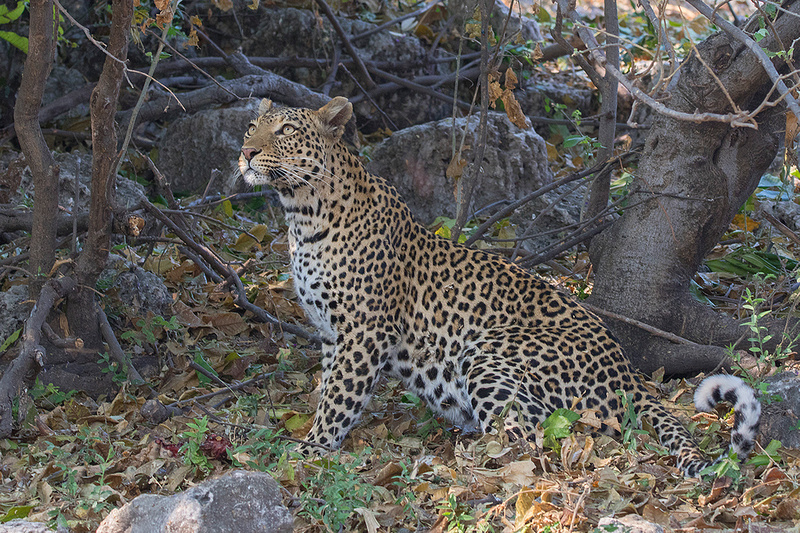
 Leopard
Leopard
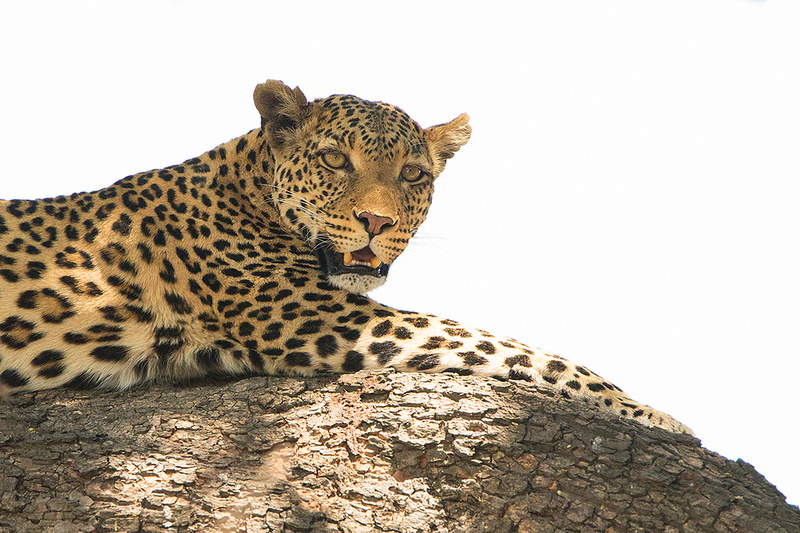
 Leopard
Leopard
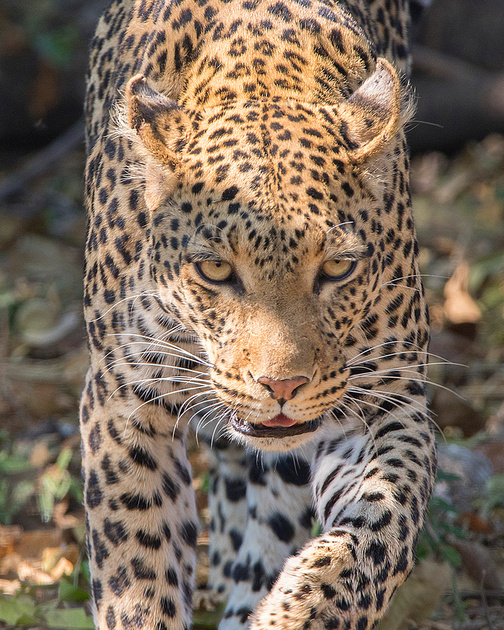

Leopard
We had been cautioned that hippos can be extremely aggressive if you get between them and the safety of water. We found a large male hippo alongside the road and he charged at very close range. Lots of dust, hissing, drooling and open mouth threat gestures. Pretty impressive. Crocodiles kill more humans in Africa than any other predator, but hippos lead the list for herbivores. After lunch we encountered numerous small herds of elephant along the open floodplain which offered some excellent views of their behavior.


Agressive Hippo
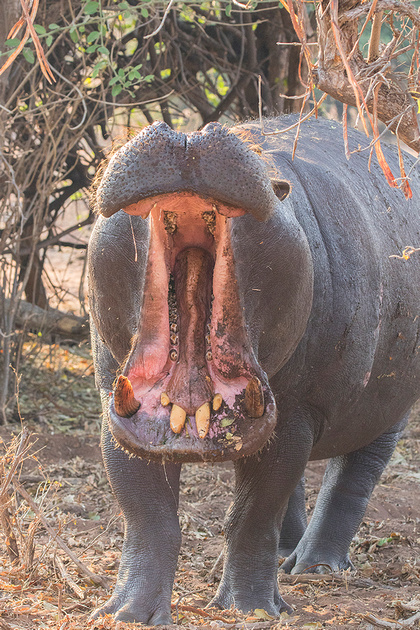

Hippo Threat Display
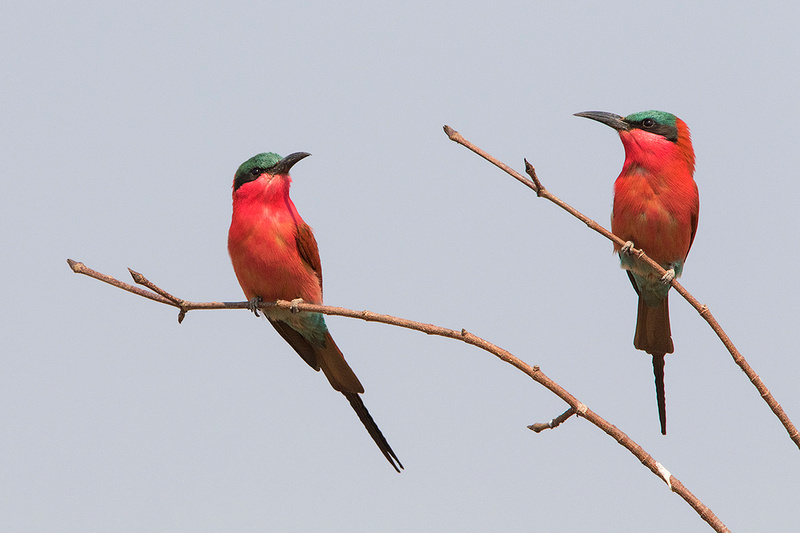
 Southern Carmen Bee Eaters
Southern Carmen Bee Eaters
We departed Baobob Camp before daylight on September 25th. I had packed away my camera equipment for the 50 minute drive, so of course we saw two spotted hyena, two adult male lions, and six wild dogs along the road as we drove through the park on our way to Kasane Airport. AGHHH! I did snag a few very grainy wild dog photos out of the bus window using my I-phone.
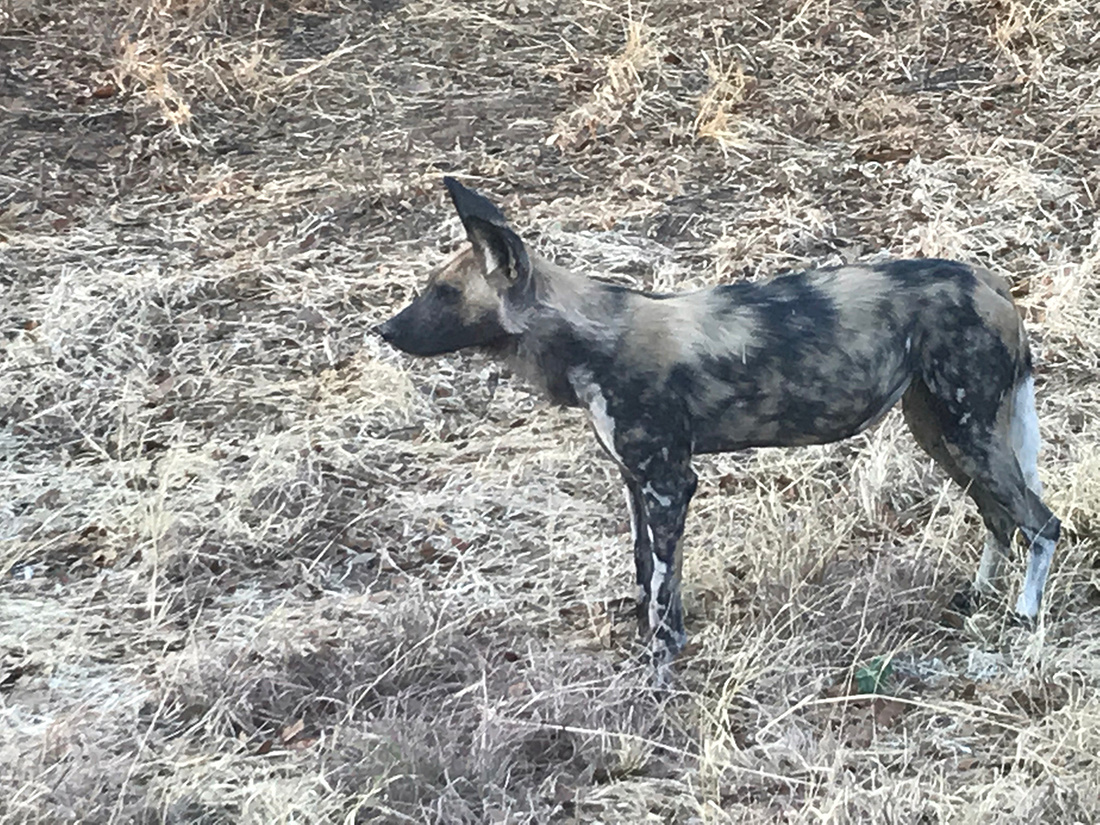
 African Wild Dog
African Wild Dog
We flew from Kasane Airport to Santawani Camp on a tributary to the Okavango Delta adjacent to Moremi National Park. This camp had access to a private concession which allowed off-road travel. This allows animals to be located by following their tracks cross country. We did a brief late morning game drive and settled into camp. Temperatures here were quite warm with mid day temperatures over 100 degrees. On our first afternoon game drive we tracked a leopard to its kill. The cat had stashed an impala in a tree and gave us some nice photo opportunities. We also tracked and located a pride of six lions. In addition, we encountered kudu, impala, warthog, elephants and baboons. A very good start for Santawani Camp.


Leopard
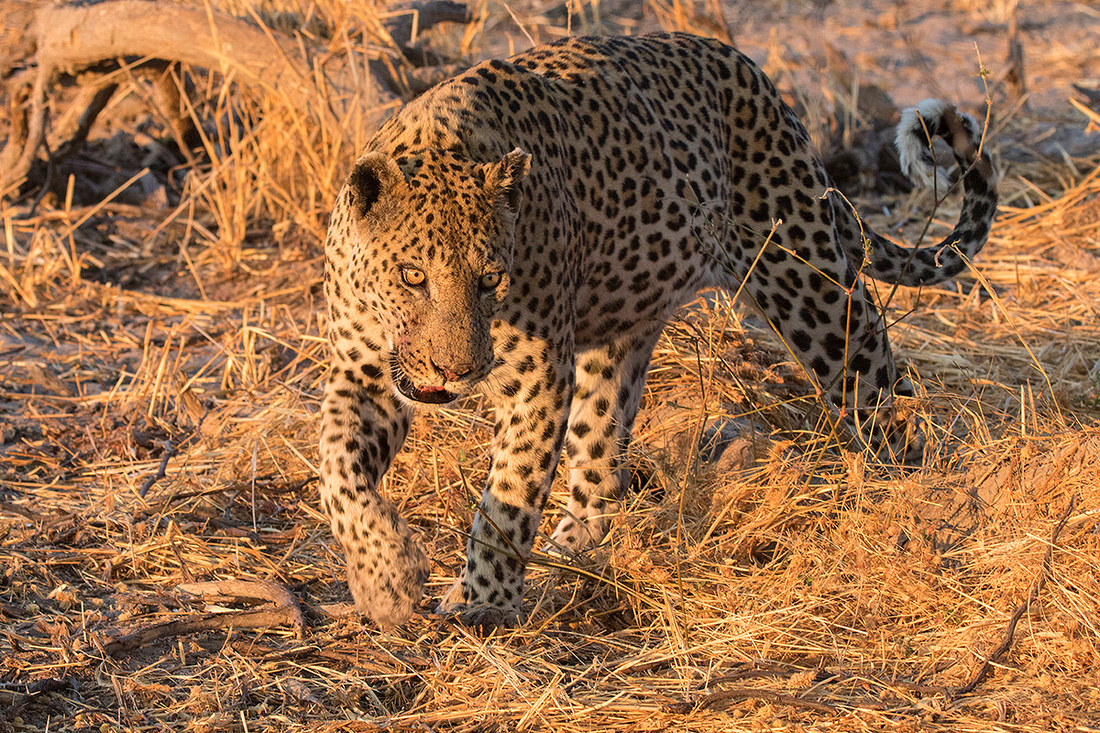
 Leopard
Leopard
Santawani Camp had a smallish manmade waterhole about 150 yards from camp. This water source was used by an almost unending stream of wildlife all day long.
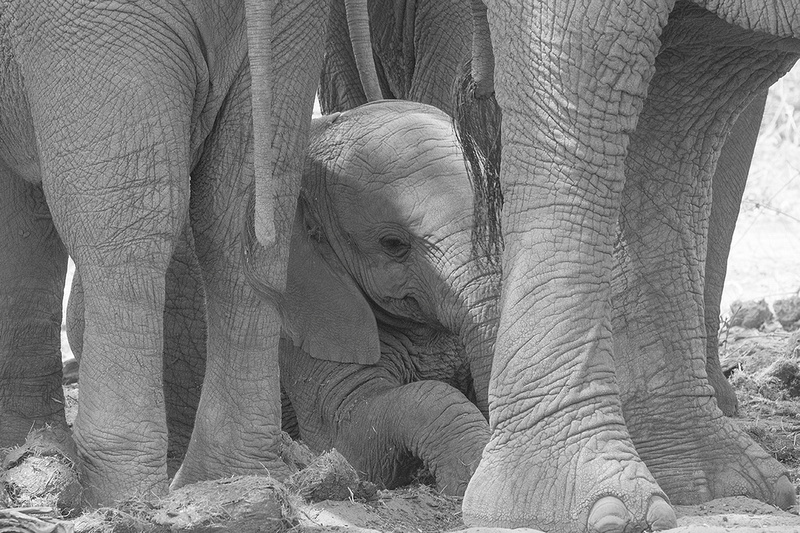
 Elephants at Camp Waterhole
Elephants at Camp Waterhole
Shortly after daylight on September 26 we were treated to a sighting of a honey badger digging away near the waterhole. September 26th was one of our most productive game drive days with hundreds of elephants observed along the river.

 Elephants
Elephants
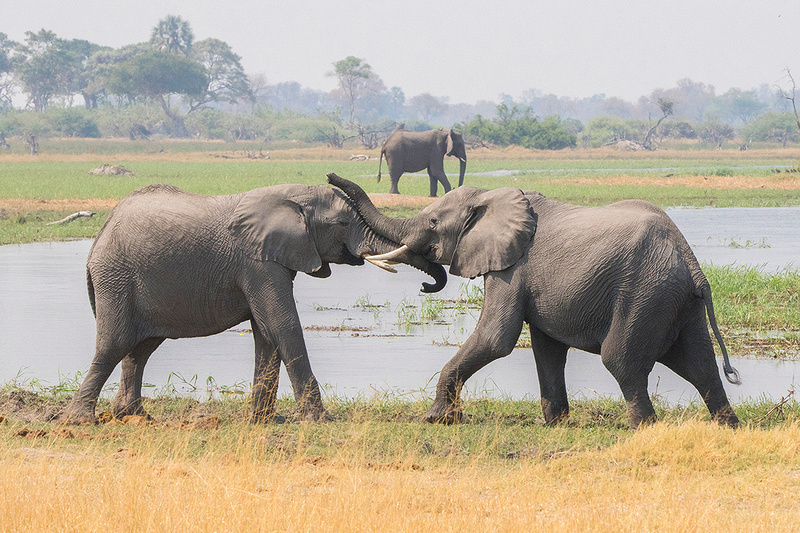
 Grudge Match
Grudge Match
In addition, we photographed kudu, warthog, giraffe, buffalo, red lechwe, jackal, steenbuck, slender mongoose, impala, wildebeest, crocodile, hippo, baboon, vervet monkey, lion, leopard, yellow mongoose, and dwarf mongoose. The area near the river was very lush with dense stands of tall grasses and sedges. Red lechwe are an antelope common in the delta and strongly associated with the wet areas near the river.
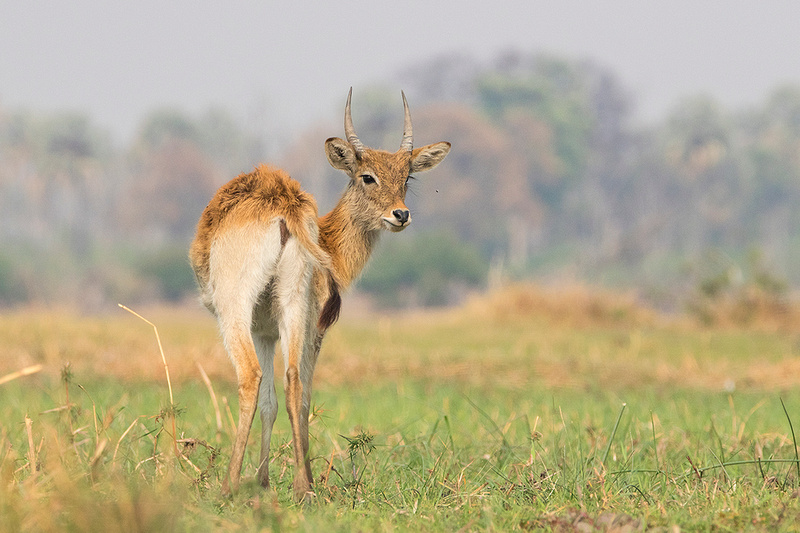
 Red Lechwe
Red Lechwe
On September 27th we encountered many of the same species as on the previous day. However, we also observed and photographed ostrich, zebra and a pride of eight lions. We had the excitement of elephants in camp and at the waterhole all day, which made it difficult to walk through camp. We made several attempts to skirt around all the elephants and get to afternoon high tea.
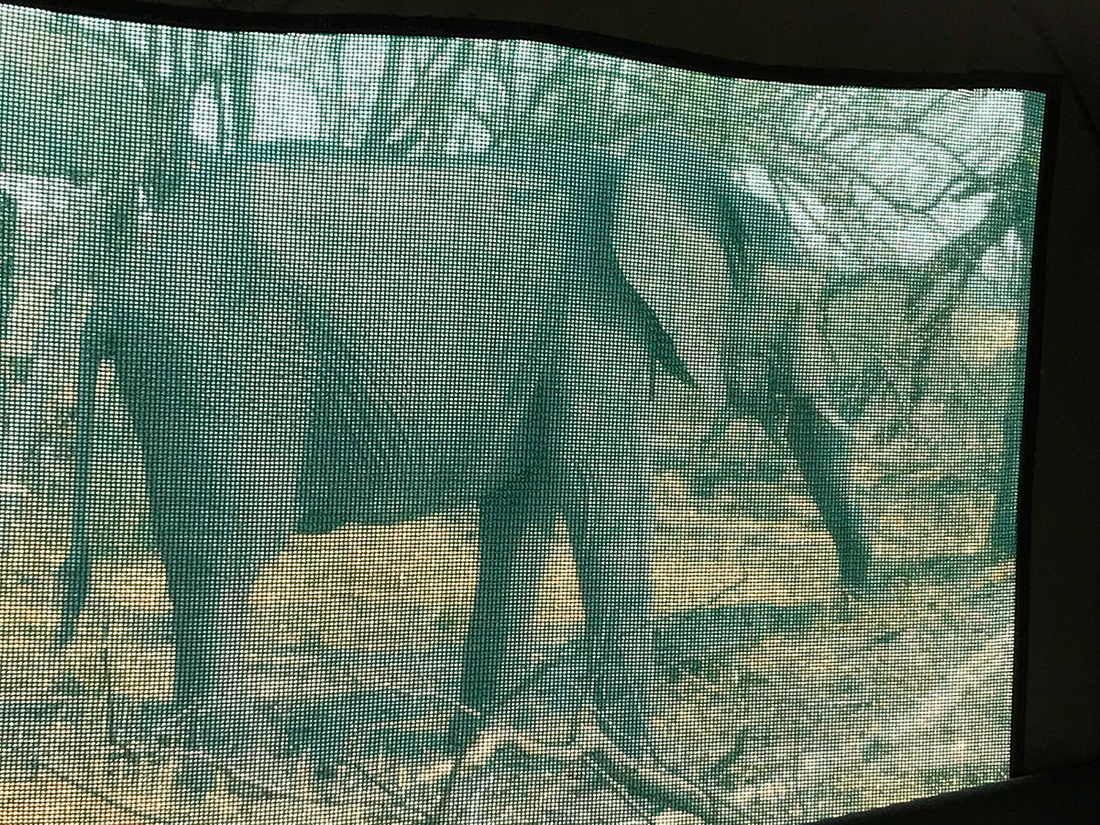
 Elephant Through the Screen Window of our Tent
Elephant Through the Screen Window of our Tent

 Adult Male Ostrich
Adult Male Ostrich
September 28th was our last morning game drive as we worked the area near camp and the airstrip. We had some nice looks at black-backed jackals, elephants, impala, warthog, and waterbuck. We also tracked a lioness to her napping location. She was out in the open and allowed a close approach in nice morning light. At some point she tired of us disturbing her nap and gathered her legs under her and starting lashing her tail. She charged, covering half the distance to the truck in her first bound. Fortunately, she decided not to continue her charge and walked away into the brush. Way to close. The guide commented that he had never seen a lion react that way before.
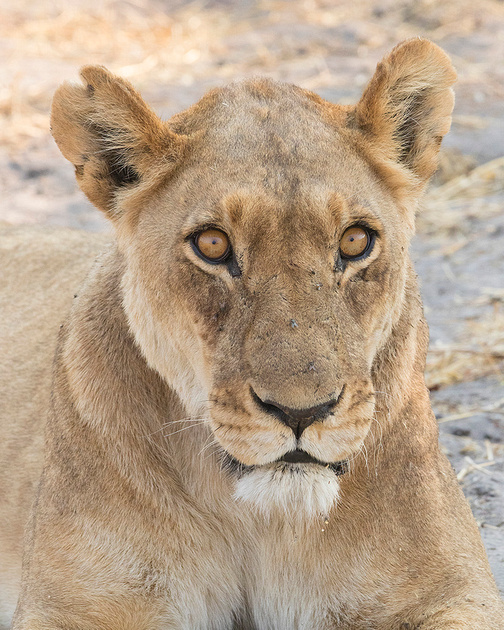

Sleepy Lioness
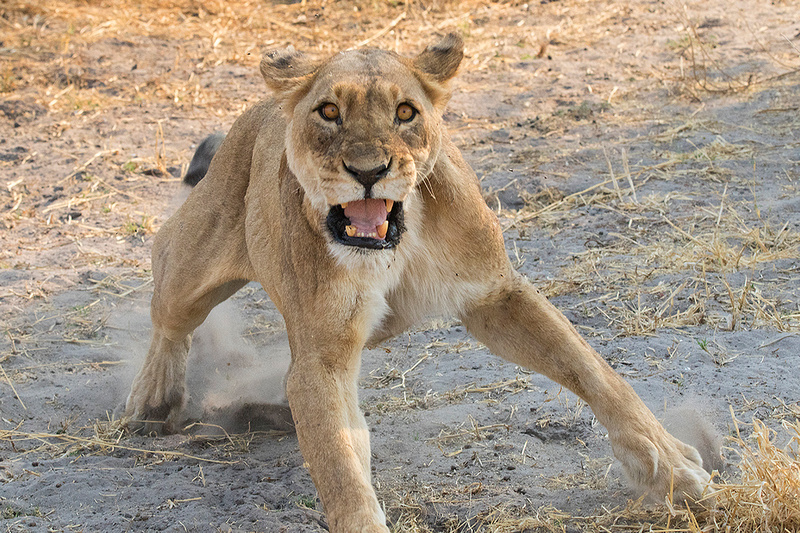

Charging Lioness at 150mm


Warthog
We flew back to Kasane Airport on September 28th and transferred by bus to Victoria Falls, Zimbabwe. We stayed the next two nights at Shearwater Explorers Village. The air conditioning was most welcome. We visited Victoria Falls that afternoon. Victoria Falls is considered the largest curtain of water in the world and one of the seven wonders of the world. Peak flow exceeds 1.4 billion gallons of water per minute. September 28th turned out to be World Tourism Day and Victoria Falls Park offered free admission. It was extremely crowded. Even late in the dry season the falls are still impressive with a maximum drop of over 110 meters. During the wet season the falls are nearly a mile wide. Photography may be easier during the dry season as the mist from the falls at full flow is reported to be quite dense.
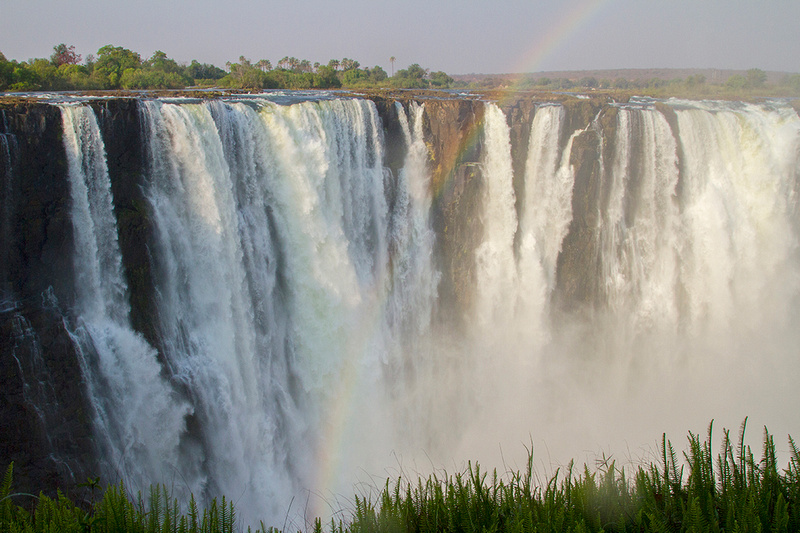
 Victoria Falls
Victoria Falls
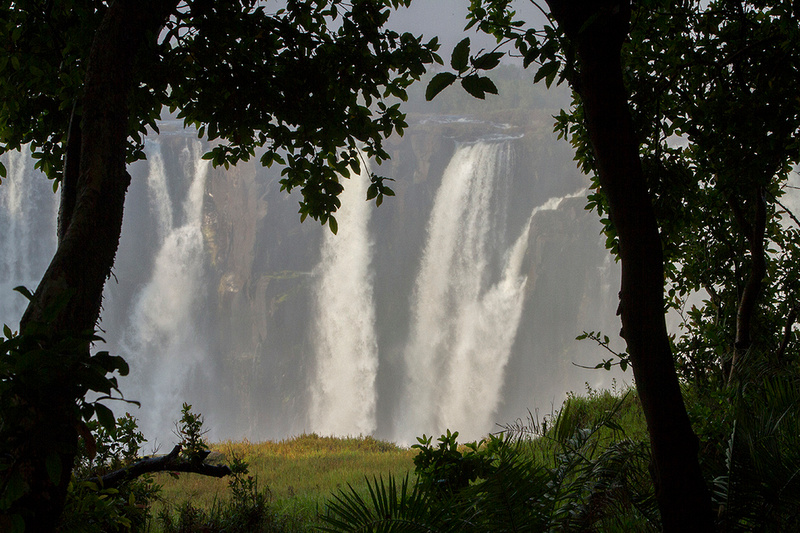
 Victoria Falls
Victoria Falls
On September 29th we opted for a private morning birding tour on the Zambezi River. We added a few additional species to the life bird list. Wildlife sightings were relatively sparse. We did find a elephant laying down asleep on the riverbank and many hippos.

 African Jacana
African Jacana
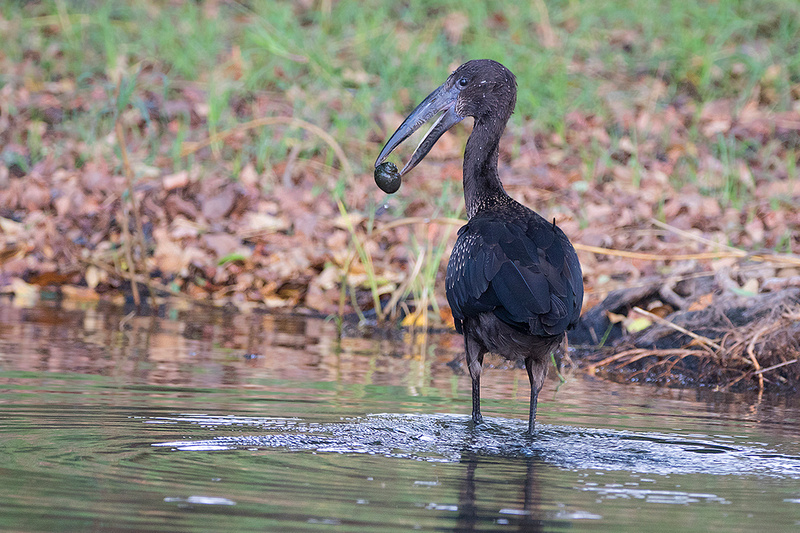
 African Openbill Stork
African Openbill Stork
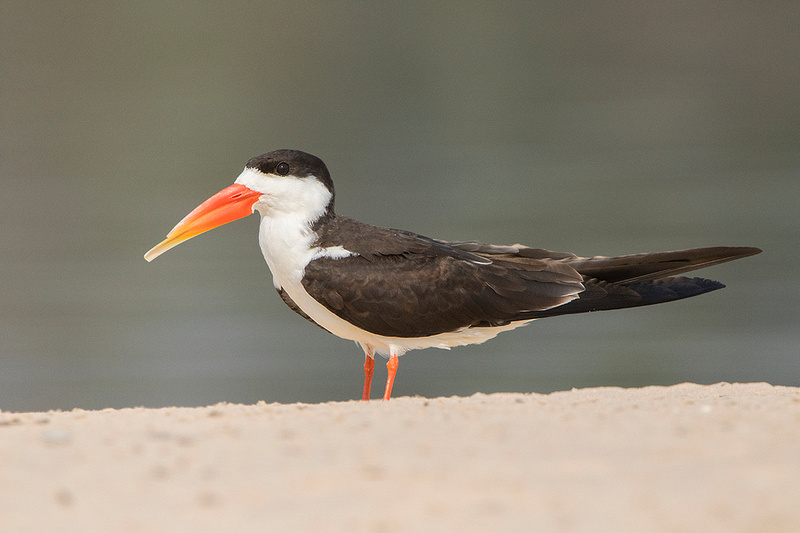
 African Skimmer
African Skimmer
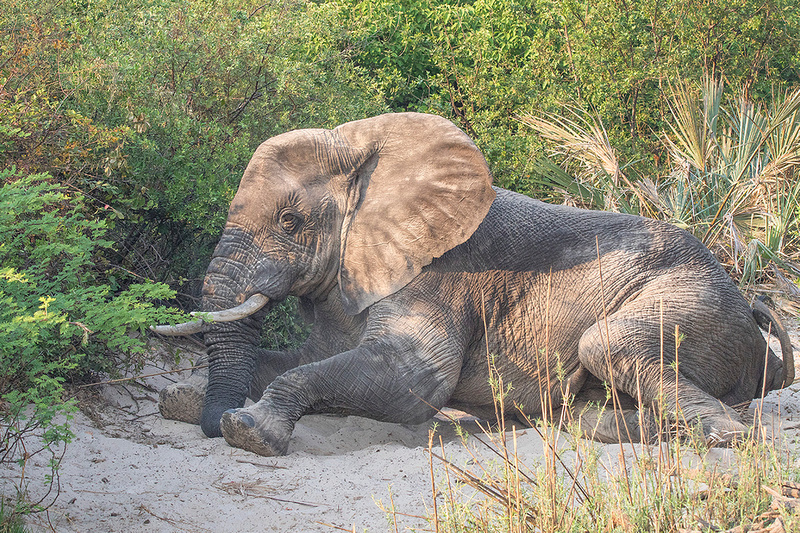
 Sleepy Elephant
Sleepy Elephant
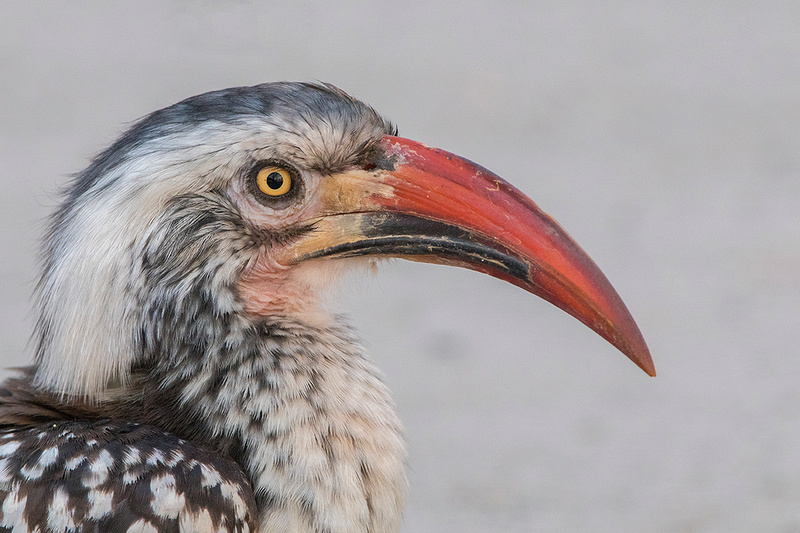

Southern Red-Billed Hornbill
We did some shopping at the local open air market and purchased some Shona stone statuary and wood carvings. Bartering and trade were expected and welcomed. American t-shirts, hats and shoes were readily accepted as currency. Our farewell sunset dinner was served onboard a large boat while cruising the Zambezi River. The next morning we began our 40 hours of travel to return home.
The OAT Ultimate Africa trip greatly exceeded my expectations. I would also highly recommend the pretrip to the game reserve in South Africa.
I purchased two apps for my phone before the trip which proved useful. These apps were "Stuart's Complete Guide to the Mammals of Africa" and "Sasol E-Birds of Southern Africa". The hardcover field guides would be preferable, but the 44 pound weight limit mitigated against packing several large field guides. I ended up with 140 life birds from the trip and have at least two additional bird photos which I have yet to identify.
I came home with a little over 16,000 photos. Almost all of the wildlife photos included here were captured using a Canon 7D2 crop-frame camera and a Sigma 150-600mm telephoto zoom lens. The zoom lens proved entirely adequate. A camera with better low light capabilities would have been useful under a few situations.


The End